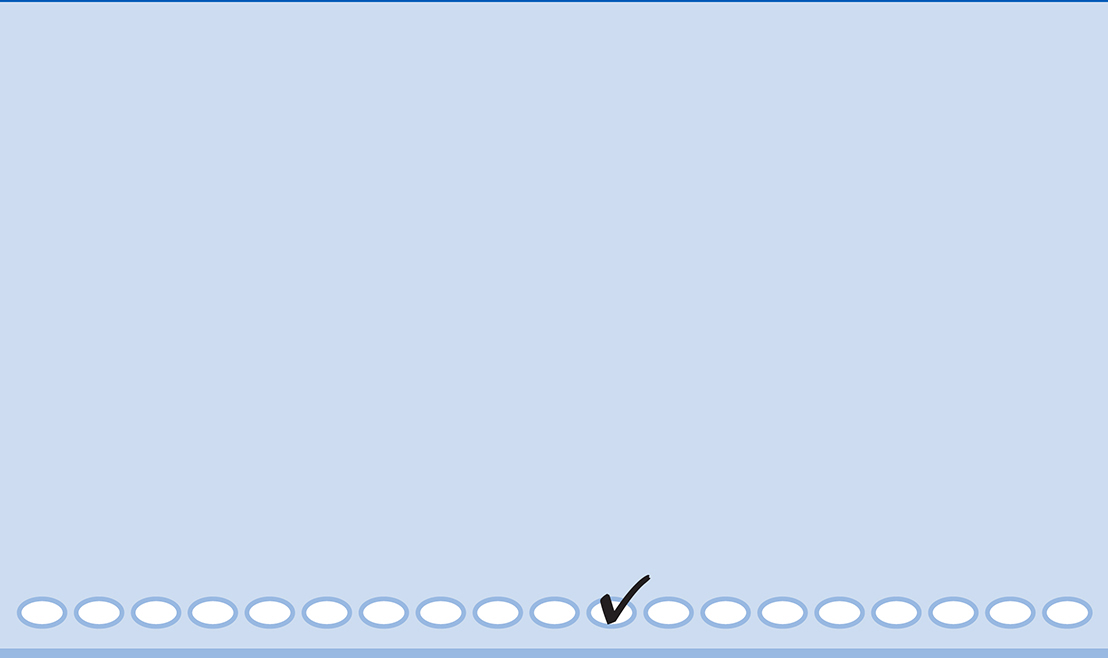
ANSWER SHEET for PRACTICE TEST 2
Use a No. 2 pencil and fill in the entire circle darkly and completely. If you change your response, erase as completely as possible


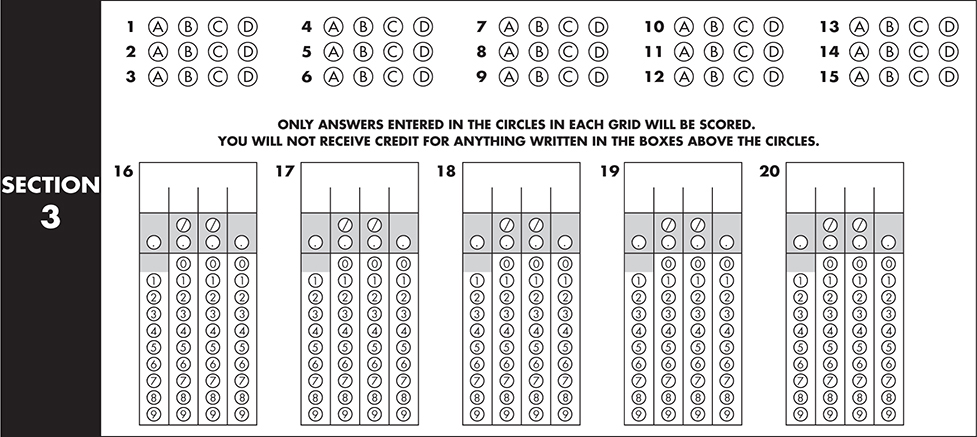
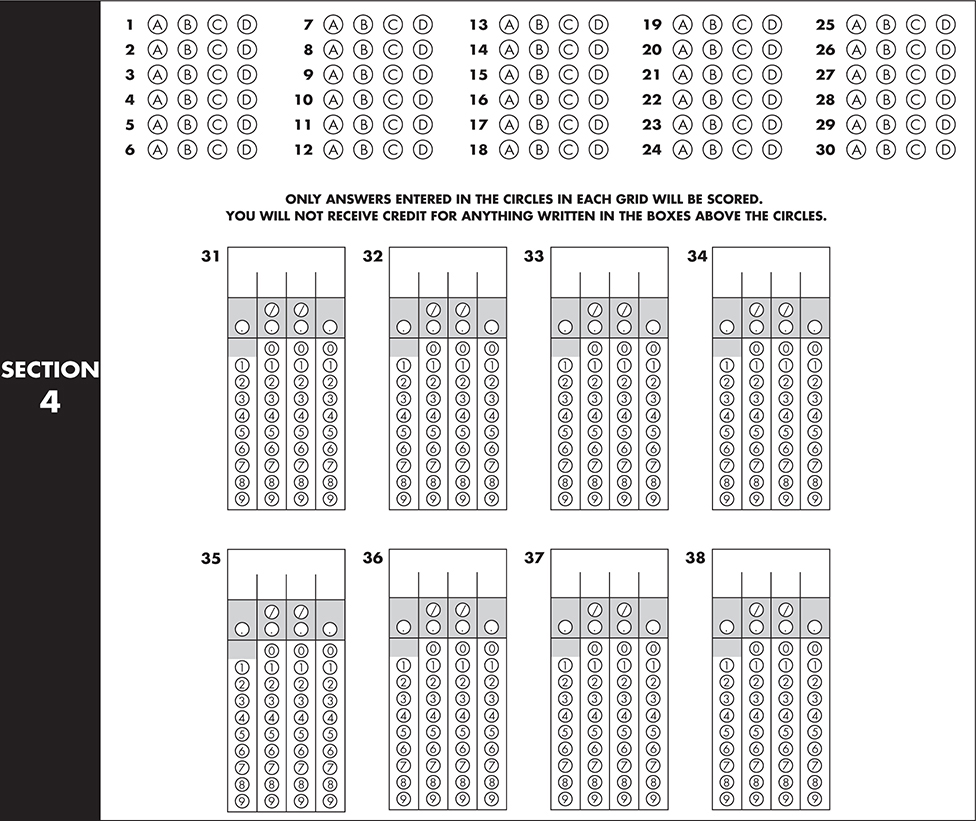
SECTION 5: ESSAY
PLANNING PAGE You may plan your essay in the unlined planning space below, but use only the lined pages following this one to write your essay. Any work on this planning page will not be scored.

BEGIN YOUR ESSAY HERE

DO NOT WRITE OUTSIDE OF THE BOX.

DO NOT WRITE OUTSIDE OF THE BOX.

DO NOT WRITE OUTSIDE OF THE BOX.

Test begins on the next page.

Reading Test
65 MINUTES, 52 QUESTIONS
Turn to Section 1 of your answer sheet to answer the questions in this section.
DIRECTIONS
Each passage or pair of passages below is followed by a number of questions. After reading each passage or pair, choose the best answer to each question based on what is stated or implied in the passage or passages and in any accompanying graphics.
Questions 1–10 are based on the following passage.
This passage is from Ralph Waldo Emerson, “Prudence.” Public domain. First published in 1841.

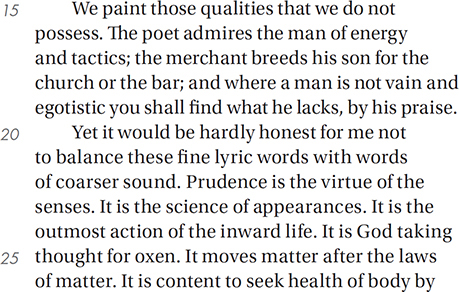
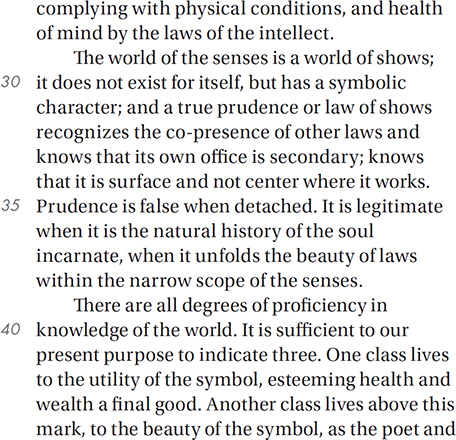

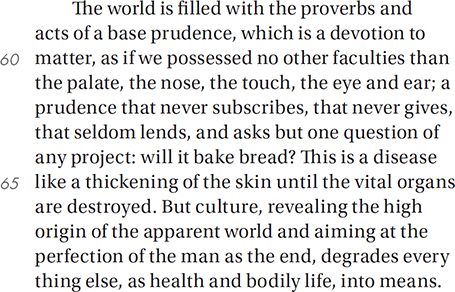
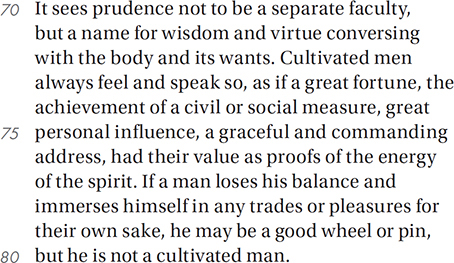
The tone of the first paragraph is best described as
A) self-effacing.
B) pontifical.
C) aspirational.
D) sardonic.
The author’s reference to “some other garden” (lines 8–9) primarily suggests that he
A) finds solace in the art of planting.
B) seeks new challenges and experiences.
C) considers arable land to be a valuable resource.
D) lacks the particular skills associated with farming.
In line 11, “title” most nearly means
A) ownership.
B) office.
C) authority.
D) publication.
The author believes that he is justified in acting as an authority on prudence primarily because of his
A) experience in making decisions.
B) regret for his past mistakes.
C) studies in classical philosophy.
D) yearning for wisdom.
Which choice provides the strongest evidence for the answer to the previous question?
A) Lines 6–9 (“I have no skill … some other garden”)
B) Lines 13–14 (“We write from … as well as from experience”)
C) Lines 20–22 (“Yet it would … coarser sound”)
D) Lines 26–28 (“It is content … laws of the intellect”)
The passage suggests that members of the “third class” (line 46) are superior for their ability to
A) solve important problems.
B) discern sublime qualities.
C) create works of beauty.
D) reason logically.
The “houses and barns” (line 54) represent
A) an unwise allegiance to worldly things.
B) the rejection of mere symbols.
C) the nobility of living with nature.
D) the importance of strong belief.
In line 59, “base” most nearly means
A) supportive.
B) ignoble.
C) necessary.
D) straightforward.
The “disease” mentioned in line 64 is best described as
A) apathy.
B) gluttony.
C) sensuousness.
D) egotism.
The passage as a whole characterizes prudence primarily as.
A) the aspiration to wisdom and righteousness.
B) a commitment to aesthetic principles.
C) the pursuit of practical skills and sensory experience.
D) the noble pursuit of spiritual goals.
Questions 11–21 are based on the following passage.
This passage is from Joseph Conrad, The Secret Sharer. It was originally published in 1912. The narrator of this story is the captain of a ship about to begin a voyage.

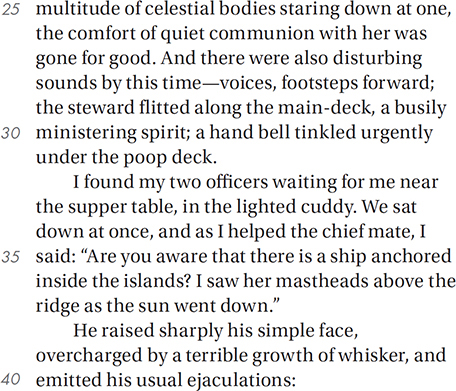


The tone of the first paragraph (lines 1–13) is primarily one of
A) reflective anticipation.
B) anxious dread.
C) unrestrained excitement.
D) objective analysis.
The reference to “some glare” (line 14) serves primarily to make the point that
A) the mastheads of another ship were not immediately visible.
B) the weather was about to change.
C) the ocean around the ship was choppy.
D) the crew was eager to get into the open sea.
In lines 20–24 (“The tide … friend”) the narrator describes
A) signs of impending danger.
B) reflections of his deep inner turmoil.
C) objects of wistful contemplation.
D) the recollection of a tragic experience.
The captain is portrayed primarily as
A) self-conscious and diffident.
B) rugged and adventurous.
C) anxious and short-tempered.
D) scholarly yet intimidating.
Which choice provides the strongest evidence for the answer to the previous question?
A) Lines 4–5 (“At that moment … her decks”)
B) Lines 24–27 (But, with … for good”)
C) Lines 48–51 (“In consequence … fortnight before”)
D) Lines 63–66 (“But I … himself secretly”)
In line 55, “bearing” most nearly means
A) direction.
B) demeanor.
C) relevance.
D) endurance.
In line 70, “evolve” most nearly means
A) change slowly.
B) ponder strenuously.
C) persuade earnestly.
D) advance randomly.
The “truth” to which the narrator refers in lines 57 is his
A) skepticism about his crew’s ability.
B) apprehension about a dangerous voyage.
C) lack of self-confidence.
D) sense that he may be going insane.
In line 82, “exercised” most nearly means
A) practiced.
B) strengthened.
C) utilized.
D) disquieted.
The “collaboration” (line 68) refers to an act of
A) selfless assistance.
B) deliberate menace.
C) contrived deceit.
D) strained contemplation.
The chief mate believed that, compared to the recently discovered ship, the “scorpion” (line 75) was
A) less explicable.
B) more frightening.
C) more ominous.
D) less miserable.
Questions 22–32 are based on the following passages.
Passage 1 is from Lindsay Smith-Doyle, “Thoughts on the Value of Life.” ©2015 by College Hill Coaching. Passage 2 is from C. F. Black, “Who’s Afraid of Cloning?” ©2015 by College Hill Coaching. Since 1996, when scientists at the Roslin Institute in England cloned a sheep from the cells of another adult sheep, many have debated the ethics of cloning human cells. These passages are excerpts from arguments on this issue.
Passage 1
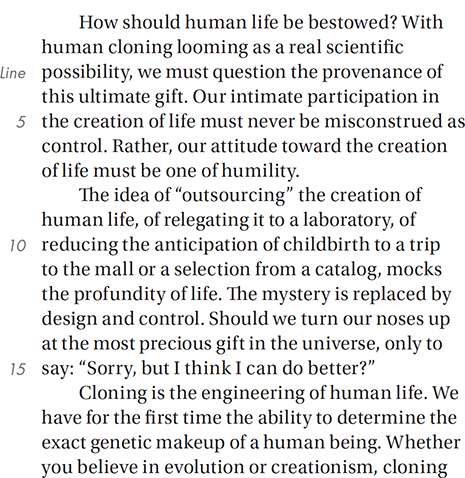

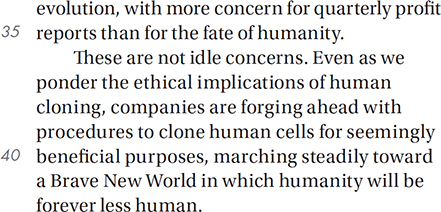
Passage 2
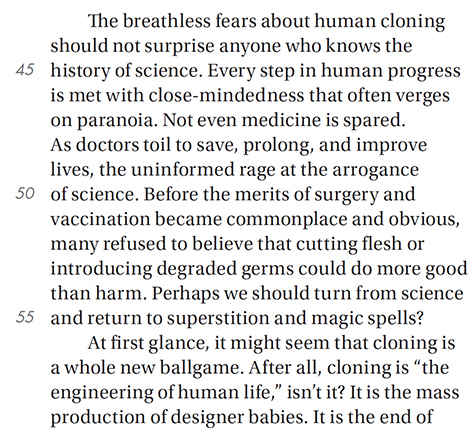
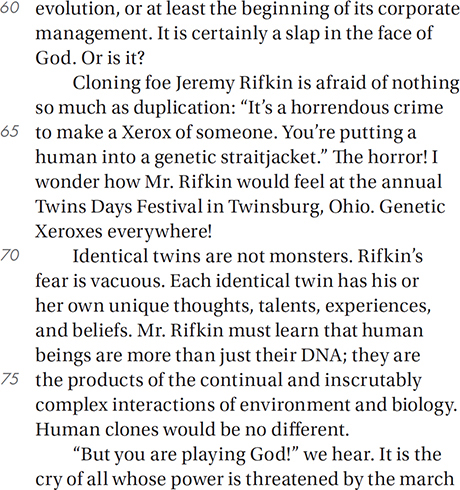

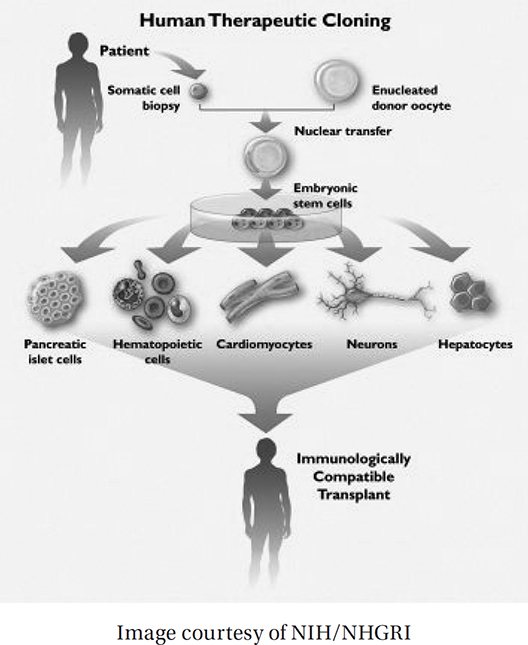
In line 13, “control” refers specifically to control over
A) the effects of cloning.
B) the development of genetic technologies.
C) the process of conception.
D) the ethical debate about cloning.
In Passage 1, the author’s attitude toward “outsourcing” (line 8) is one of
A) grudging approval.
B) blunt disdain.
C) firm support.
D) ironic detachment.
The quotations in line 15 and line 78 are similar in that both
A) represent the opinions of cloning opponents.
B) indicate cautious advocacy for genetic engineering.
C) are presented as being insincere.
D) contradict the viewpoints of the respective authors.
Jeremy Rifkin (line 63) would most likely advocate
A) the “humility” mentioned in line 7.
B) the “design and control” mentioned in line 13.
C) the “engineering” mentioned in line 16.
D) the “industries” mentioned in line 30.
The diagram best illustrates
A) the “guided purpose” (line 22).
B) the “assembly line” (line 25).
C) the “course of human evolution” (lines 33–34).
D) the “procedures” (line 39).
In line 53, “introducing” refers to an act of
A) explanation.
B) proposition.
C) announcement.
D) injection.
The author of Passage 1 would most likely regard the “management” (line 61) described in Passage 2 as
A) a necessary measure to avoid the abuse of procreative technologies.
B) an acceptable means by which the medical community can find alternatives to cloning.
C) a regrettable invasion of commercial interests into human reproduction.
D) a dangerous impediment to the development of effective cloning techniques.
Passage 2 quotes Jeremy Rifkin in lines 64–66 primarily to
A) exemplify an untenable position.
B) illustrate the potential dangers of cloning.
C) reveal the interests of the corporate community.
D) cite a corroborating opinion from an expert.
Passage 2 refers to the Twin’s Days Festival in line 68 as an example of
A) a movement that promotes beneficial cloning.
B) a seemingly harmless event that harbors hidden dangers.
C) the innocuousness of genetic duplication.
D) the logical consequences of procreative technologies.
The author of Passage 2 would most likely argue that the “procedures” (line 39) to which the author of Passage 1 objects are in fact
A) inconsequential aspects of the cloning debate.
B) necessary contributions to medical progress.
C) not representative of the methods used by real genetic researchers.
D) ways of manipulating public opinion.
Which choice provides the strongest evidence for the answer to the previous question?
A) Lines 59–61 (“It is the end … management”)
B) Lines 71–73 (“Each identical … beliefs”)
C) Lines 80–82 (“It is the reasoning … place”)
D) Lines 95–100 (“With genetic … organs”)
Questions 33–42 are based on the following passage.
This passage is from Steven Pinker, An Invitation to Cognitive Science (Gleitman, Liberman, and Osherson, eds.) ©1995 by Bradford Book.



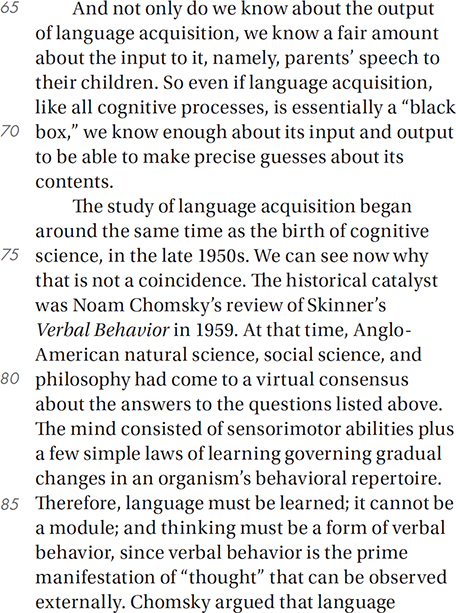
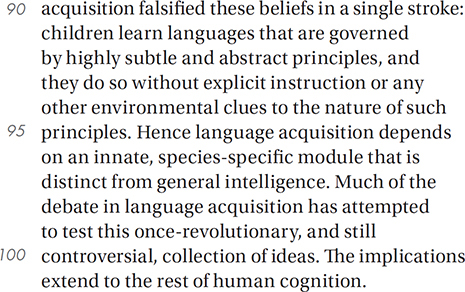
This passage as a whole is primarily concerned with
A) delineating the general principles of linguistics.
B) comparing the structural qualities of various languages.
C) exploring academic questions about how we learn language.
D) examining the claims of one influential linguist.
The “data” mentioned in line 6 most likely include information regarding
A) the literacy levels of various countries.
B) methods for teaching infants to speak.
C) the syntax rules of different languages.
D) the structures of the human cerebral cortex.
In line 2, “the two” refers to
A) self and other.
B) thinking and expressing.
C) grammar and syntax.
D) learning and teaching.
In line 15, “sticking” most nearly means
A) applying.
B) upholding.
C) piercing.
D) maintaining.
The author’s attitude toward Whorf’s “hypothesis” (line 18) is best described as
A) dismissive.
B) supportive.
C) ambivalent.
D) antagonistic.
The statement “Babies can think before they can talk” (line 27) is intended to indicate that
A) learning to talk is much more cognitively challenging than most people believe.
B) skills associated with basic reasoning are not dependent on verbal communication.
C) both physical and cognitive skills tend to develop according to rigid timelines.
D) researchers sometimes do not take into account the particular needs of infants.
Which if the following best summarizes the author’s view on human language acquisition?
A) Learning a language is a crucial step in learning to think, because thinking is verbal behavior.
B) The structures for learning language seem to be much simpler than what scientists previously thought.
C) Humans are born with very intricate cognitive structures for learning language.
D) Environmental input is more important than heredity in language acquisition.
Which choice provides the strongest evidence for the answer to the previous question?
A) Lines 1–3 (“Language is … intimately related”)
B) Lines 23–24 (“Language acquisition … to talk”)
C) Lines 61–64 (“The same … Vietnamese”)
D) Lines 95–97 (“Hence language … general intelligence”)
In line 62, “structure” refers to
A) the grammatical rules of a language.
B) the functional organization of the mind.
C) the environment in which infants learn.
D) the systems for investigating linguistic claims.
The subjects listed in lines 78–80 are given as examples of disciplines that, in 1959,
A) accepted the hypothesis that cognition depends on verbal skills.
B) considered the scientific method inadequate to the study of language acquisition.
C) regarded most of the processes in involved in language acquisitions to be innate.
D) questioned the conventional theories regarding how humans learn language.
Questions 43–52 are based on the following passage and supplementary material.
This passage is from A. R. Kirchoff, “The New Ecosystems of the Anthropocene” ©2017 by College Hill Coaching.
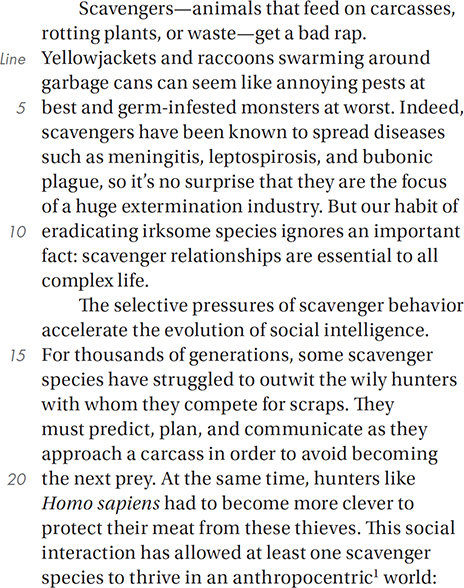

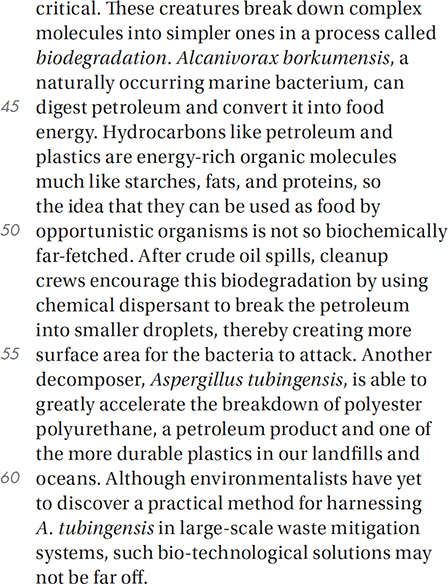
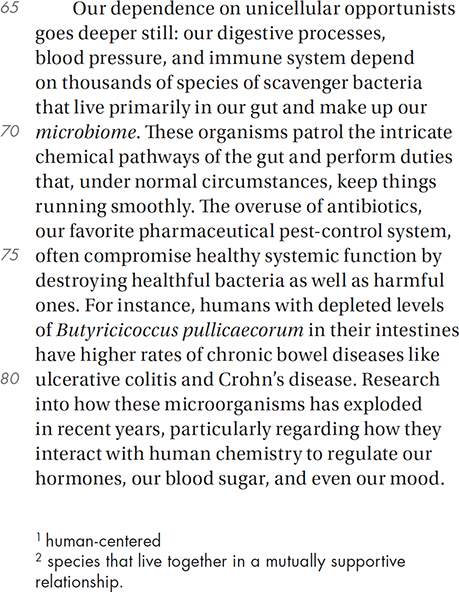
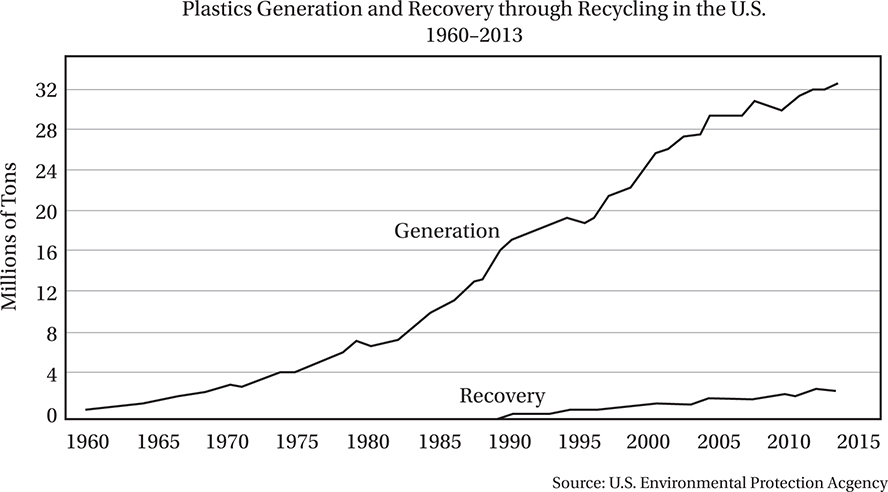
This passage primarily serves to
A) examine several specific ecosystems that are currently dominated by scavengers and discuss ways of preserving those ecosystems.
B) explore various ways in which scavengers can be beneficial to different ecosystems that are relevant to humans.
C) explain how scavengers acquire intelligent behavior through a long evolutionary process involving interaction with humans.
D) discuss the ways that humans can exploit the beneficial behaviors of scavengers while avoiding the diseases that they spread.
In line 33, “perspicacious” is used to describe scavengers that can
A) avoid predation by humans.
B) decompose complex hydrocarbons.
C) distinguish nutritious waste from toxic waste.
D) develop mutually beneficial social relationships.
Considering the information in the passage, the graph would be most directly relevant to a discussion of
A) the domestication of Canis lupus familiaris.
B) the proliferation of Alcanivorax Butyricicoccus.
C) the habitat of Aspergillus tubingensis.
D) the health benefits of Butyriiccoccus pullicaecorum.
The passage indicates that the social intelligence of scavengers enables them to
A) track increasingly elusive prey.
B) find more nutritious food sources.
C) avoid predation by clever hunters.
D) protect their food supply.
Which choice provides the best evidence for the answer to the previous question?
A) Lines 13–14 (“The selective … intelligence”)
B) Lines 17–20 (“They must … prey”)
C) Lines 20–22 (“At … thieves”)
D) Lines 26–29 (“Your pet … forebears”)
As used in line 41, “complex” most nearly means
A) large and intricate.
B) obscure and bewildering.
C) delicate and complicated.
D) convoluted and unfathomable.
As used in line 52, “encourage” most nearly means
A) inspire.
B) goad.
C) invigorate.
D) persuade.
The passage indicates that one hurdle to using microorganisms extensively to degrade plastic waste is that
A) they may produce toxic chemicals as a by-product.
B) they are not common to the most highly polluted ecosystems.
C) their populations are not easily controlled by environmentalists.
D) they compete with other biodegrading scavengers.
Which choice provides the best evidence for the answer to the previous question?
A) Lines 46–51 (“Hydrocarbons … far-fetched”)
B) Lines 51–55 (“After … attack”)
C) Lines 55–60 (“Another … oceans”)
D) Lines 60–64 (“Although … off”)
The last paragraph (lines 65–84) serves mainly to
A) indicate additional benefits that scavenger bacteria provide by describing how they support vital biological functions in humans.
B) provide another example of the benefits provided by microscopic scavengers by describing how bacteria enable researchers to develop better antibiotics.
C) draw a contrast to the previous discussion about the benefits of bacteria by describing some of the potential dangers of infection.
D) demonstrate how our fear of bacteria prevents us from taking full advantage of the medicinal benefits of microorganisms.
STOP
If you finish before time is called, you may check your work on this section only. Do not turn to any other section of the test.

Writing and Language Test
35 MINUTES, 44 QUESTIONS
Turn to Section 2 of your answer sheet to answer the questions in this section.
DIRECTIONS
Each passage below is accompanied by a number of questions. For some questions, you will consider how the passage might be revised to improve the expression of ideas. For other questions, you will consider how the passage might be edited to correct errors in sentence structure, usage, or punctuation. A passage or a question may be accompanied by one or more graphics (such as a table or graph) that you will consider as you make revising and editing decisions.
Some questions will direct you to an underlined portion of a passage. Other questions will direct you to a location in a passage or ask you to think about the passage as a whole.
After reading each passage, choose the answer to each question that most effectively improves the quality of writing in the passage or that makes the passage conform to the conventions of Standard Written English. Many questions include a “NO CHANGE” option. Choose that option if you think the best choice is to leave the relevant portion of the passage as it is.
Questions 1–11 are based on the following passage and supplementary material.
Who Really Owns American Media?
In this era of blogging, news websites, and personalized Twitter feeds, most of us believe that we have more choice than ever 1 in how we get our news. But unless you’re particularly 2 apt about the world of journalism, you might be surprised to learn how few choices we really have.
Thirty years ago, 50 different corporations owned 90% of the American broadcast and news media. Today, just 6 large conglomerates 3 have the same control over that media, which is still 90%. These huge corporations have successfully lobbied the U.S. Congress to loosen or dismantle federal antitrust regulations. These regulations were designed to prevent any one corporation from driving out 4 their competition and controlling public discourse. The debate on this issue centers on the balance between liberties and governmental interference. Some argue that a corporation’s freedom to acquire media and voice its opinion trumps any right the public may have to diverse points of view. 5 The other argument would be that our constitutional freedom of the press requires regulation in order to maintain a free market of ideas and an informed citizenry.
A) NO CHANGE
B) with getting
C) of the way we get
D) of getting
A) NO CHANGE
B) acute
C) savvy
D) comprehensive
A) NO CHANGE
B) control that same 90% of all media
C) control the same media, all 90% of it
D) are in the same 90% control of all media
A) NO CHANGE
B) the competition they have
C) its competition
D) it’s competition
A) NO CHANGE
B) Others argue
C) Others would argue
D) Another being
According to data from 2007, the American media does not quite look like America. Although fully 33% of the American population was minority, 6 only 3.2% of American broadcast television outlets were controlled by minorities.
One potent antidote 7 regarding media consolidation is the Internet. 8 With some research, it reveals many resources for the curious and intelligent media consumer to hear informed voices from a wide variety of perspectives.
Which of the following best represents the information from Figure 1?
A) NO CHANGE
B) only 3.2% of the minority population controlled American broadcast television outlets
C) only 3.2% of the American population included minorities in control of broadcast television outlets
D) only 3.2% of American broadcast television stations were watched by minorities
A) NO CHANGE
B) about
C) against
D) to
A) NO CHANGE
B) It will reveal with some research
C) Some research will reveal
D) With some research, it will reveal

9 Although the Web abounds with gossip, partisanship, and fear-mongering from many major outlets, and conspiracy theorists on the fringe, the careful viewer can also find thoughtful analysis and civilized debate of the issues. Sites like ProPublica, FactCheck.org, and NPR provide in-depth, nonprofit, public-supported journalism that is less influenced by any corporate or political agenda.
10 Therefore, sensationalism sells, and the media conglomerates have mastered the art. As the first great American media mogul, William Randolph Hearst, said, “If you want the public in sufficient numbers, construct a highway. Advertising is that highway.” Without large advertising and lobbying budgets, these nonpartisan 11 instances of journalism will have a difficult time competing with the big boys.
The author wants to introduce this sentence with a representation of modern media that contrasts with the ideal of “civilized debate.” Does this sentence accomplish this task?
A) Yes, because it suggests that controversial matters are ignored in modern media.
B) Yes, because it refers to relatively unsophisticated modes of conversation.
C) No, because it focuses on entertainment rather than any examination of issues.
D) No, because it refers to hypothetical situations rather than real ones.
A) NO CHANGE
B) Still
C) Lastly
D) In summary
A) NO CHANGE
B) patterns
C) receptacles
D) repositories
Questions 12–22 are based on the following passage.
The Dangers of Superstition
Have you ever knocked on wood to dodge a jinx? Do you avoid stepping on cracks in the sidewalk? Do you feel uneasy about the number 13? Most of us realize that these 12 rituals, which are based on ancient and discredited beliefs, but we can’t so easily rid our minds of superstitious thinking. Every culture has its own superstitious beliefs, 13 and now anthropologists and psychologists are beginning to understand why.
Our brains constantly work to find cause-and-effect patterns in the world. When something strange happens that we can’t explain, or seems to 14 collid against what we already believe, we get an uncomfortable feeling known as “cognitive dissonance.” We reflexively fill this gap in knowledge with the explanations that are most easily available to us. 15 Since we are willful beings surrounded by other willful beings, and every conscious moment of our lives is filled with a sense of “agency,” 16 that is: intentional action. Therefore, we imagine tiny beings living in wood, or vaporous spirits roaming the clouds that do strange or harmful things when we displease them. Willful agency is our “default” explanation.
A) NO CHANGE
B) rituals, that are based on
C) rituals have been based on
D) rituals are based on
A) NO CHANGE
B) for
C) so
D) while
A) NO CHANGE
B) contradict
C) disengage
D) go away from
A) NO CHANGE
B) Because we
C) We
D) So we
A) NO CHANGE
B) that is, intentional action
C) which is what intentional action is
D) which is: intentional action
[1] Our brains are creative. [2] They can design buildings, compose music, and 17 can formulate scientific theories. [3] But this creativity is sometimes hard to discipline, and so we are susceptible to strange thoughts and superstitions. [4] Many of these, like blessing people when they sneeze, are harmless if not quaint. [5] In 2014, villagers in Nigeria brought a goat into a police station, accusing it of being a witch that had attempted to steal a car and then changed into a goat. 18
A) NO CHANGE
B) also can formulate
C) have formulated
D) formulate
The author is considering adding the following sentence to this paragraph.
Others are sad and bizarre, such as the belief in shape-shifting.
Where should it be placed?
A) before sentence 2
B) before sentence 3
C) before sentence 4
D) before sentence 5
Although superstitious explanations relieve our cognitive dissonance, 19 it might also lead to tragedy. In 2014, people in Paraguay and Tanzania were killed because locals accused them of witchcraft. 20 Some superstitious parents have even beaten or disowned their own children because their strange behavior is attributed to demonic possession. Superstitions are also not harmless when they impede the pursuit of science, placing obstacles in the way of medical and technological breakthroughs that can improve the human condition.
Rituals intended to help your favorite football team score, like dancing or wearing your hat backward, are fun and innocuous. They 21 substitute a craving in our brains for control over situations that otherwise mystify us. 22
A) NO CHANGE
B) it can
C) they can
D) they would
A) NO CHANGE
B) Some superstitious parents, believing that any strange behavior is a sign of demonic possession, have even beaten or disowned their own children.
C) Even beating or disowning their own children, many superstitious parents attribute their strange behavior to demonic possession.
D) Some superstitious parents, believing that their strange behavior is a sign of demonic possession, have even beaten or disowned their own children.
A) NO CHANGE
B) discharge
C) exempt
D) satisfy
Which concluding sentence is most in keeping with the content and tone of the passage as a whole?
A) However, feeling like we have control over a situation is not always the same as understanding it.
B) They represent some of humanity’s greatest accomplishments, and have inspired some of our greatest works of art.
C) Centuries from now, our rituals may become so elaborate that we would scarcely recognize them as such today.
D) Without such rituals, we would not feel as connected to the people or the natural world around us.
Questions 23–33 are based on the following passage.
Skepticism and the Scientific Method
Even scientists sometimes forget how essential skepticism, particularly self-skepticism, is to the scientific process. But scientific skepticism is driven by evidence, not agenda. Today, the field of climatology seems to have more than its share of skeptics, debating 23 a warming planet and the things that should be done by us about it, if anything.
24 They are coming from outside of the scientific community, many of these skeptics couch their arguments in political terms. Some claim that global warming is part of a partisan “left-wing” plot or a ploy by the scientific community to ensure funding for yet another “Chicken Little” scare. Others suggest that attempts to reduce greenhouse gas emissions by changing energy or land use policies 25 would provide a needless cost of the American taxpayer of tens to hundreds of billions of dollars annually. Some even suggest that they are really part of an international conspiracy to undermine America’s competitiveness in the global marketplace.
A) NO CHANGE
B) what should be done about a warming planet, if we should
C) what, if anything, we should do about a warming planet
D) the things we should do about a warming planet, if we should
A) NO CHANGE
B) While coming
C) Their coming
D) Coming
A) NO CHANGE
B) would be needless in costing the American taxpayer
C) would needlessly cost the American taxpayer
D) is a needless cost to the American taxpayer of
At the same time, others who legitimately question the data or theories related to climate change are too quickly labeled right-wing “deniers,” even if their concerns are not motivated by any partisan convictions.
In fact, science has, or should have, nothing to do with ideology. Rather, it 26 is a process of identifying significant natural phenomena, gathering evidence about those phenomena, and 27 then we must find the most reliable explanation for that evidence. The preponderance of the evidence suggests that the earth is getting warmer, that the effects of that warming will be problematic, that there are things we can do to prevent or at least mitigate the worst outcomes, and 28 perhaps that many of these things are well worth doing. There is still plenty of uncertainty about the complex systems that make up our planetary climate, but we know enough to be concerned, 29 and to discuss the issue without politicizing it.
A) NO CHANGE
B) accounts for
C) represents
D) symbolizes
A) NO CHANGE
B) finding the most reliable explanation for
C) then explaining in the most reliable way
D) finding the most reliable way for explaining
A) NO CHANGE
B) also that many of these things perhaps may be
C) many of these things perhaps may be
D) that many of these things may be
Which choice is most consistent with the main idea of the passage?
A) NO CHANGE
B) and to expose the agendas of those who stand in the way of saving our planet
C) but not enough to risk sacrificing our political or economic security
D) and to create a strong incentive program to transform our national energy policy
The skeptics point out, rightly, that science isn’t about consensus. The fact that 98% of climatologists regard something as true 30 isn’t the same as it being true. After all, only centuries ago the majority of physicians worldwide believed that illnesses were caused not by germs or genetics, 31 but by demons or imbalances in “humors.”
[1] Having an honest and productive conversation about global warming 32 requires an educated public. [2] When we, as public citizens, become more informed about the science of climatology, we become less susceptible to political sniping and to “consensus” as an argument. [3] Most important, perhaps, we become better able to make good decisions about the future of our nation and our planet. 33
A) NO CHANGE
B) won’t make that true
C) would not mean it’s that way
D) doesn’t make it so
A) NO CHANGE
B) but instead from
C) but from
D) they thought it was by
A) NO CHANGE
B) requires the need for
C) requires our being
D) require having
The writer is considering adding the following sentence into this paragraph.
Furthermore, we become more adept at evaluating the facts and theories at the heart of the matter.
Where should it be placed?
A) before sentence 1
B) before sentence 2
C) before sentence 3
D) after sentence 3
Questions 34–44 are based on the following passage.
The Magic of Bohemia
Bohemia is a landlocked country in central 34 Europe, and until 1918 they were ruled from Vienna by the Austrian Hapsburgs. Today it 35 regards a major part of the modern Czech Republic, and its largest city, Prague, serves as the nation’s capital. Bohemia is also another, less clearly defined country, a country of the mind. This Bohemia in fact derives from misconceptions about the true Bohemia that go back as far as Shakespeare, 36 designating Bohemia as the land of gypsies and the spiritual habitation of artists.
By 1843, when Michael William Balfe’s opera The Bohemian Girl premiered in London, the term Bohemian 37 would come to mean any wandering or vagabond soul, who need not have been associated with the arts. The Parisian poet Henry Murger clinched the term’s special association with the life of artists.
In November 1849, a dramatized version of Murger’s Latin Quarter tales was staged in Paris with the title La Vie de Bohème. So extraordinarily successful 38 did this prove that the stories themselves were published as Scènes de la Vie de Bohème. The public’s appetite was whetted and a popular cult of the gypsy-artist was underway. Murger’s volume of stories became the textbook for the artistic life throughout the late nineteenth and early twentieth centuries.
A) NO CHANGE
B) Europe, until 1918 it was ruled
C) Europe, which, until 1918, was ruled
D) Europe, having been, until 1918, ruled
A) NO CHANGE
B) amounts to
C) establishes
D) comprises
A) NO CHANGE
B) who designated Bohemia
C) he had designated Bohemia
D) being designated by him
A) NO CHANGE
B) had come to mean
C) came to have meant
D) had meant
A) NO CHANGE
B) was this proven
C) this was proved
D) this proved
39 What was it that were the basic elements of this Bohemia as it evolved under Murger? To start with, Bohemia belonged to the romantic movements that preached the power of the individual imagination and came to adopt a secular religion of art. Like early Christianity, it had its true believers and its heathens. The believers in this case were the artists themselves, the elect of the spirit, touched with the divine power of imagination, while the heathen were the commercial middle classes who had 40 propagated as a result of increased commodity production in the wake of the Industrial Revolution.
[1] To the artists, these were people of no imagination who were only concerned with material things. [2] As Philistines, they seemed inhabit a different country from that of the 41 Bohemians; Murger’s achievement was to define, quite persuasively, the boundaries of Bohemia in terms of a particular lifestyle. [3] In his Bohemia, the production of art was in fact less important than 42 whether one had the capacity for art. [4] Murger was also responsible for the term Bohemian becoming inseparably linked with the supposedly unconventional, outlandish behavior of artists, yet it is evident that he did not invent Bohemianism. [5]
A) NO CHANGE
B) What were they that were the basic elements
C) What basic elements were there
D) What were the basic elements
A) NO CHANGE
B) propitiated
C) prospered
D) preempted
A) NO CHANGE
B) Bohemians, Murger had the achievement of defining
C) Bohemians, but Murger’s achievement was in defining
D) Bohemians; but Murger achieved defining
B) NO CHANGE
B) the capacity for art
C) whether one has the capacity for art
D) one’s capacity of art
Most of its ingredients had existed in Paris for at least two decades before he started writing. 43
Bohemia had been a haven for the political rebel and, as the nineteenth century drew to a close, more than one French observer had seen it as the breeding-ground of cynicism, as the source of much potential danger. “It is quite clear,” Jules Claretie wrote indignantly in 1888, “that every country has its Bohemians. But they do not have the influence over the rest of the nation which they do in France—thanks to that poisonous element in the French character which is known as la blague—or cynicism.” 44
The writer is considering adding the following sentence to this paragraph.
Murger can thus be described as a Bohemian of the second generation.
Where should it be placed?
A) after sentence 1
B) after sentence 2
C) after sentence 3
D) after sentence 5
If the author were to delete the quotation from Jules Claretie at the conclusion of this paragraph, the passage would primarily lose
A) an optimistic view of the late nineteenth-century French culture.
B) a scathing perspective on Murger’s literary work.
C) a dire assessment of France’s national temperament.
D) an urgent warning against a potential immigration problem.
STOP
If you finish before time is called, you may check your work on this section only. Do not turn to any other section of the test.

Math Test – No Calculator
25 MINUTES, 20 QUESTIONS
Turn to Section 3 of your answer sheet to answer the questions in this section.
DIRECTIONS
For questions 1–15, solve each problem, choose the best answer from the choices provided, and fill in the corresponding circle on your answer sheet. For questions 16–20, solve the problem and enter your answer in the grid on the answer sheet. Please refer to the directions before question 16 on how to enter you answers in the grid. You may use any available space in your test booklet for scratch work.
NOTES
1. The use of a calculator is NOT permitted.
2. All variables and expressions used represent real numbers unless otherwise indicated.
3. Figures provided in this test are drawn to scale unless otherwise indicated.
4. All figures lie in a plane unless otherwise indicated.
5. Unless otherwise indicated, the domain of a given function f is the set of all real numbers for which f(x) is a real number.
REFERENCE
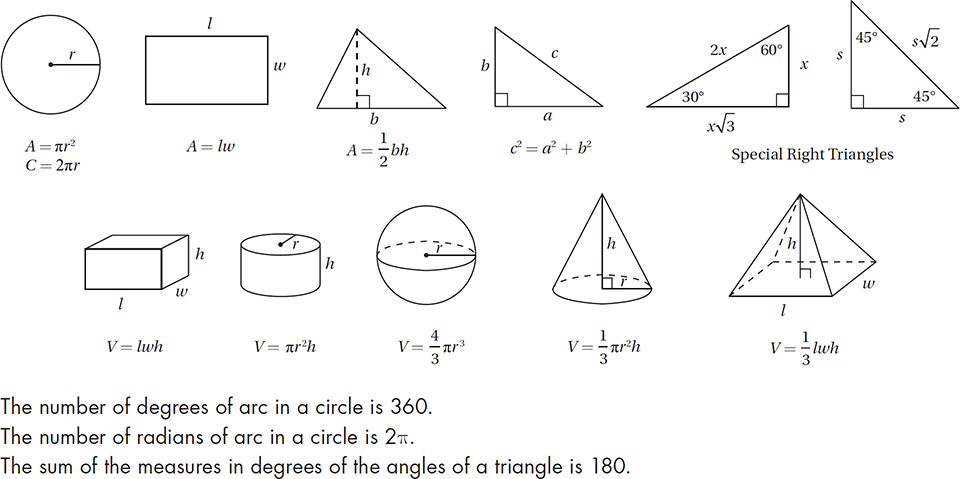
If 2b - 1 = 5, what is the value of 2b2 - 1 ?
A) 15
B) 17
C) 24
D) 25
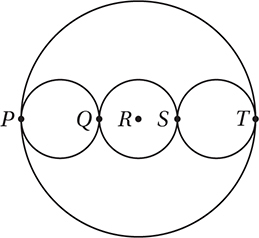
In the figure above, points P, Q, R, S, and T lie on the same line, and R is the center of the large circle. If the three smaller circles are congruent and the radius of the large circle is 6, what is the radius of one of the smaller circles?
A) 1
B) 2
C) 3
D) 4
Jeri has edited  of her term paper. If she has
of her term paper. If she has
edited 15 pages, how many pages does she have left to edit?
A) 45
B) 50
C) 60
D) 75
7, 12, 22, 42, 82
Which of the following gives a rule for finding each term in the sequence after the first?
A) Add 5 to the preceding number.
B) Add 5 to the sum of all of the preceding terms.
C) Double the preceding term and then subtract 2 from the result.
D) Add 14 to the preceding term and divide that result by 2.
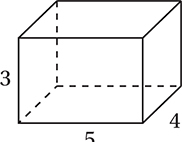
The figure above shows a rectangular box. What is the longest length of a diagonal of one of the faces of this box?
A) 
B) 
C) 
D) 
Which of the following points is NOT on the graph of the line -2x - 3y = 36 in the xy-plane?
A) (-9, 6)
B) (-24, 4)
C) (6, -16)
D) (12, -20)
During a coyote repopulation study, researchers determine that the equation P = 250(1.32t describes the population P of coyotes t years after their introduction into a new region. Which of the following gives the values of I, the initial population of coyotes, and r, the annual percent increase in this population?
A) I = 250, r = 32%
B) I = 250, r = 132%
C) I = 330, r = 32%
D) I = 330, r = 132%
Which of the following is equal to  ?
?
A)
B)
C)
D)
Which of the following could be the x-intercept and y-intercept of a line that is perpendicular to the line 3x + 6y = 0 ?
A) (-6, 0) and (0, 3)
B) (3, 0) and (0, -6)
C) (3, 0) and (0, 6)
D) (6, 0) and (0, 3)
The function f is defined by the equation f(x) = x - x2. Which of the following represents a quadratic with no real zeros?
A) 
B) 
C) 
D) 
In the xy-plane, the graph of the line  intersects the graph of the equation y = x2 + x at two points. What is the distance between these two points?
intersects the graph of the equation y = x2 + x at two points. What is the distance between these two points?
A) 
B) 
C) 
D) 4
If i2k = 1, and  , which of the following must be true about k ?
, which of the following must be true about k ?
A) k is a multiple of 4.
B) k is a positive integer.
C) When 2k is divided by 4, the remainder is 1.
D)  is an integer.
is an integer.
For all numbers x and y, let z be defined by the equation z = |22 - x2 - y2| + 22. What is the smallest possible value of z ?
A) 0
B) 4
C) 8
D) 16
If the polynomial P(x) has factors of 12, (x - 5), and (x + 4), which of the following must also be a factor of P(x) ?
A) 2x2 + 8
B) 4x2 - 20
C) 6x2 - 6x - 120
D) x2 - 10x + 25
If f(x) = -x + 7 and g(f(x)) = 2x + 1, what is the value of g(2) ?
A) -11
B) -5
C) 5
D) 11
DIRECTIONS
For questions 16–20, solve the problem and enter your answer in the grid, as described below, on the answer sheet.
1. Although not required, it is suggested that you write your answer in the boxes at the top of the columns to help you fill in the circles accurately. You will receive credit only if the circles are filled in correctly.
2. Mark no more than one circle in any column.
3. No question has a negative answer.
4. Some problems may have more than one correct answer. In such cases, grid only one answer.
5. Mixed numbers such as  must be gridded as 3.5 or
must be gridded as 3.5 or  .
.
(If  is entered into the grid as
is entered into the grid as  , it will be interpreted as
, it will be interpreted as  ).
).
6. Decimal answers: If you obtain a decimal answer with more digits than the grid can accommodate, it may be either rounded or truncated, but it must fill the entire grid.

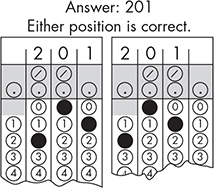
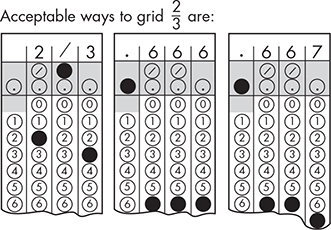
In a writer’s workshop, there are half as many men as women. If there are 24 total men and women in the writer’s workshop, how many men are there?
If  what is the value of b ?
what is the value of b ?
The square of a positive number is 0.24 greater than the number itself. What is the number?
The function f is a quadratic function with zeros at x = 1 and x = 5. The graph of y = f(x) in the xy-plane is a parabola with a vertex at (3, -2). What is the y-intercept of this graph?

STOP
If you finish before time is called, you may check your work on this section only. Do not turn to any other section of the test.

Math Test – Calculator
55 MINUTES, 38 QUESTIONS
Turn to Section 4 of your answer sheet to answer the questions in this section.
DIRECTIONS
For questions 1–30, solve each problem, choose the best answer from the choices provided, and fill in the corresponding circle on your answer sheet. For questions 31–38, solve the problem and enter your answer in the grid on the answer sheet. Please refer to the directions before question 31 on how to enter you answers in the grid. You may use any available space in your test booklet for scratch work.
NOTES
1. The use of a calculator is permitted.
2. All variables and expressions used represent real numbers unless otherwise indicated.
3. Figures provided in this test are drawn to scale unless otherwise indicated.
4. All figures lie in a plane unless otherwise indicated.
5. Unless otherwise indicated, the domain of a given function f is the set of all real numbers for which f(x) is a real number.
REFERENCE

If  and 2a + 4b = 20, what is the value of b ?
and 2a + 4b = 20, what is the value of b ?
A) 2.5
B) 4
C) 5
D) 15
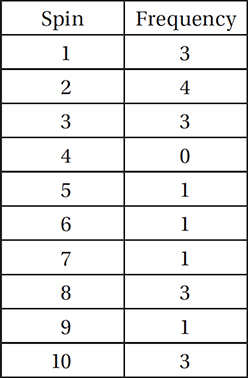
The spinner for a board game has 10 sectors, numbered 1 through 10. It is spun 20 times and the results summarized in the table above. What is the median value of these 20 spins?
A) 2
B) 4
C) 5
D) 6
A 48-gram serving of breakfast cereal contains 8 grams of sugar. How many grams of sugar are there in a 57-gram serving of the same cereal?
A) 9.5
B) 10.5
C) 11.5
D) 12.5

The graph above shows the number of applicants and finalists for a statewide college scholarship program over four consecutive years. For which year was the ratio of finalists to applicants the greatest?
A) 2010
B) 2011
C) 2012
D) 2013
If y3 = 20 and z2 = 10, what is the value of (yz)6 ?
A) 2 × 105
B) 4 × 104
C) 2 × 105
D) 4 × 105
If the sum of a, b, and c is three times the sum of a and b, which of the following expresses the value of a in terms of b and c ?
A) 
B) 
C) 
D) 
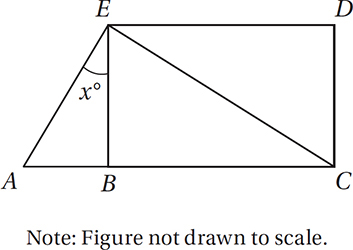
In the figure above, BCDE is a rectangle, AC = 14, BC = 12, and EC = 13. What is the value of tan x ?
A) 0.4
B) 0.6
C) 1.3
D) 2.5
Which of the following binomials is a factor of x2 - 6x + 8 ?
A) x - 4
B) x + 4
C) x + 2
D) x - 8

Questions 9–11 are based on the graph below.
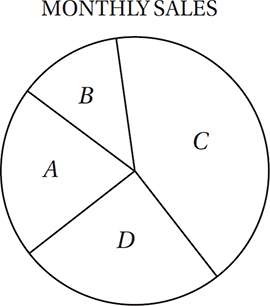
The pie graph above represents the monthly ad sales for four salespeople—Maria, Eli, Georgia, and Zoe—at a social media website. For the month, Maria’s sales accounted for 25% of the total, Eli had $3,000 in sales, Georgia had $5,000 in sales, and Zoe had $10,000 in sales.
Which sector represents Georgia’s sales for the month?
A) Sector A
B) Sector B
C) Sector C
D) Sector D
What is the sum of the monthly sales for all four salespeople?
A) $22,500
B) $24,000
C) $25,000
D) $27,000
If Eli and Georgia both earn 10% commission on their sales, and Maria and Zoe both earn 15% commission on their sales, how much more did Maria earn in monthly commissions than Georgia?
A) $300
B) $360
C) $375
D) $400

Let the function f be defined by f(x) = 2 - |x - 4| for all real values of x . What is the greatest possible value of f ?
A) -2
B) 2
C) 4
D) 6
If  , what is the value of b ?
, what is the value of b ?
A) 
B) 
C) 
D) 5
For the function f, f (1) = 4 and f (2) = 13. Which of the following equations could describe f ?
A) f(x) = x2 + 3
B) f(x) = x2 + 9
C) f(x) = 2x2 + 2
D) f(x) = 3x2 + 1
Which of the following is NOT equivalent to 12b2 ?
A) (6b)(6b)
B) 12b(b)
C) 
D) 6b2 + 6b2
If m is a number chosen randomly from the set {2, 3, 4, 6} and n is a number chosen randomly from the set {1, 2, 3, 4}, what is the probability that mn is a multiple of 12?
A) 
B) 
C) 
D) 
If y = 3x + 4 and x < 3, which of the following represents all the possible values of y ?
A) y > 7
B) y < 13
C) 7 < y < 13
D) y > 13
If g(x + 1) = x2 + 2x + 4 for all values of x, which of the following is equal to g(x) ?
A) x2 + 4
B) x2 + 3
C) (x - 1)2 + 4
D) (x - 1)2 + 3

Two sequences, A and B, follow the patterns shown above. If the nth term of sequence A is 72, what is the nth term of sequence B?
A) 125
B) 135
C) 145
D) 155
A website received 2,100 visitors in July from both subscribers and nonsubscribers. If the ratio of subscribers to nonsubscribers among this group was 2:5, how many more nonsubscribers visited the site in July than subscribers?
A) 126
B) 630
C) 900
D) 1,260

The figure above shows the locations of quadrants I–IV in the xy-plane. Which of the following represents a pair of linear equations that do NOT intersect in quadrant I?
A) 3x + 5y = 15
y = 4
B) 5x + 3y = 15
y = 4
C) 5x - 3y = 15
y = 4
D) 3x - 5y = 15
y = 4
During a 40-minute session at a 220 volt charging station, the charge on an electric car battery increases from an initial charge of 50 power units to a final charge of 106 power units. If this charge increases linearly with time, which of the following best describes the charge, q, in power units, on this same battery after charging for t hours from an initial charge of 20 power units? (1 hour = 60 minutes)
A) q = 55t + 50
B) q = 84t + 50
C) q = 55t + 20
D) q = 84t + 20

Questions 23 and 24 are based on the graph below.
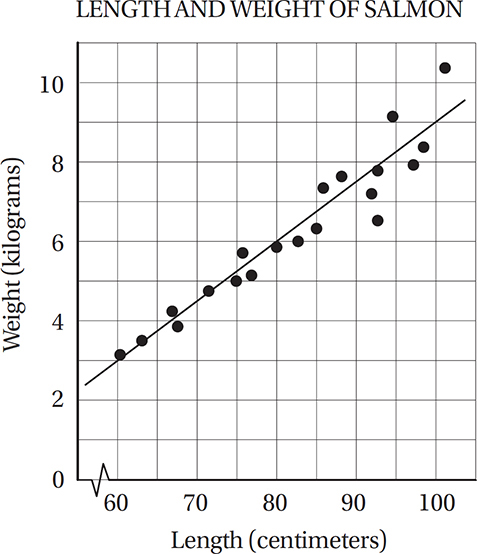
The scatterplot above shows the length and weight of a group of 20 salmon and the line of best fit for the data. According to this line of best fit, which of the following best approximates the weight, in kilograms, of a salmon that is 95 centimeters long?
A) 7.6
B) 7.8
C) 8.3
D) 8.8
Which of the following equations best describes the relationship between w, the weight in kilograms of each salmon, and l, its length in centimeters?
A) 
B) 
C) 
D) 

The average size of a compressed image file is 750 kB. If Ronika’s data plan allows her to send 2 GB of data each month before she pays any overage charges, but she plans to use 85% of that data for texting, approximately how many compressed images can she send each month before she incurs any overage charges? (1 GB = 1,000 MB; 1 MB = 1,000 kB)
A) 227
B) 400
C) 2,267
D) 4,000
Perfectioner’s Chocolate Company makes two varieties of truffles: dark chocolate and milk chocolate. Each dark chocolate truffle requires 0.65 ounces of cocoa powder, and each milk chocolate truffle requires 0.45 ounces of cocoa powder. If cocoa powder costs c dollars per pound, and Perfectioner’s Chocolate Company has budgeted $200 per week for cocoa powder, which of the following inequalities indicates the restrictions on the number of dark chocolate truffles, d, and the number of milk chocolate truffles, m, the company can make in one week? (1 pound = 16 ounces)
A) 
B) 
C) 
D) 
If n is a positive integer and m = 2n +2 + 2n, what is 2n + 3 in terms of m ?
A) m
B) 
C) 
D) 3m2
For how many values of x between 0 and 2π does sin  ?
?
A) Two
B) Three
C) Four
D) Six

The figure above shows the graphs of functions f and g in the xy-plane. Which of the following equations could express the relationship between f and g ?
A) f(x) = g(x - 2)
B) f(x) = g(x + 2)
C) f(x) = g(x) + 2
D) f(x) = g(x) - 2
A researcher is trying to estimate the daily amount of time undergraduate computer science majors spend on nonrecreational computer activities. She surveys 120 students from among the computer science majors at a large state university and asks them, “How much time do you spend in nonrecreational computer activities each day?” The mean of these responses is 210 minutes per day, with a standard deviation of 16.5 minutes. If another researcher wishes to present the same question to a new set of subjects at the same university, which of the following subject groups would most likely yield a data set with a smaller margin of error for the estimated daily amount of time undergraduate computer science majors spend on nonrecreational computer activities?
A) 240 randomly selected computer science majors
B) 240 randomly selected liberal arts majors
C) 80 randomly selected computer science majors
D) 80 randomly selected liberal art majors
DIRECTIONS
For questions 31–38, solve the problem and enter your answer in the grid, as described below, on the answer sheet.
1. Although not required, it is suggested that you write your answer in the boxes at the top of the columns to help you fill in the circles accurately. You will receive credit only if the circles are filled in correctly.
2. Mark no more than one circle in any column.
3. No question has a negative answer.
4. Some problems may have more than one correct answer. In such cases, grid only one answer.
5. Mixed numbers such as  must be gridded as
must be gridded as  .
.
(If  is entered into the grid as
is entered into the grid as  , it will be interpreted as
, it will be interpreted as  .)
.)
6. Decimal answers: If you obtain a decimal answer with more digits than the grid can accommodate, it may be either rounded or truncated, but it must fill the entire grid.
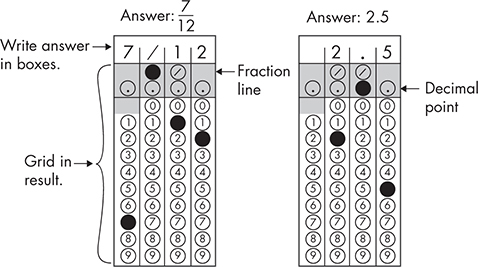
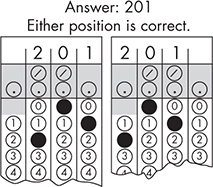
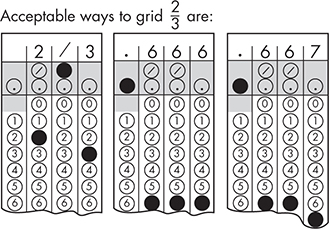
What number is 40% greater than the sum of 40 and 80 ?
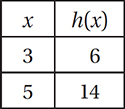
The table above shows a set of ordered pairs that correspond to the function  . What is the value of k ?
. What is the value of k ?
hx + 4y = -3
The equation above is the equation of a line in the xy-plane, and h is a constant. If the slope of this line is -13, what is the value of h ?
The sum of two numbers is four times their difference. The smaller of these numbers is 15. What is the greater number?

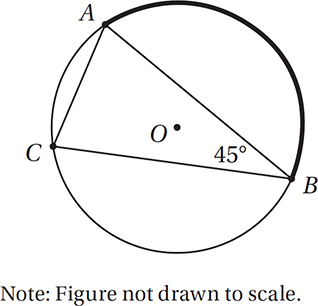
In the figure above, the circle with center O has a circumference of 50, and AB = BC. What is the length of arc AB ?

Questions 37 and 38 are based on the scenario described below.
An Internet service provider offers three different plans for residential users. Plan A charges users $500 for the first year of service, and $80 per month thereafter. Plan B charges users $68 per month. Plan C is a “high speed” plan that offers 200% higher speeds for $92 per month.
Isabelle has been using Plan A for over a year. She recently reviewed her plan and realized that if she had been using Plan B for same amount of time, she would have saved $104 for Internet service over the entire period. At the time of her review, how many months had Isabelle been on Plan A?
Isabelle is now considering switching to either Plan B or Plan C for her home business, but she calculates that having the “high speed” plan will save her only approximately 45 minutes of work each month. At what minimum hourly rate, in dollars per hour, would she have to value her work (that is, how much more would she have to value one hour of free time over one hour of work time) for Plan C to be worth the extra cost over Plan B?

STOP
If you finish before time is called, you may check your work on this section only. Do not turn to any other section of the test.

Essay
50 MINUTES, 1 QUESTION
DIRECTIONS
As you read the passage below, consider how James Schlesinger uses
• evidence, such as facts or examples, to support his claims
• reasoning to develop ideas and connect claims and evidence
• stylistic or persuasive elements, such as word choice or appeals to emotion, to add power to the ideas expressed
Adapted from James Schlesinger, “Cold Facts on Global Warming.” ©2004 by The Los Angeles Times. Originally published January 22, 2004.
1 We live in an age in which facts and logic have a hard time competing with rhetoric—especially when the rhetoric is political alarmism over global warming.
2 We continue to hear that “the science is settled” in the global warming debate, that we know enough to take significant action to counter it. Those who hold this view believe emissions of carbon dioxide are the primary cause of any change in global temperature and inevitably will lead to serious environmental harm in the decades ahead.
3 In 1997, for instance, Vice President Al Gore played a leading role in the negotiation of the Kyoto Protocol, the international agreement to deal with the fears about global warming. He was willing to embrace severe reductions in U.S. emissions, even though the Clinton administration’s own Department of Energy estimated that Kyoto-like restrictions could cost $300 billion annually. Then, when it became clear that the Senate would not agree to a treaty that would harm the economy and exempt developing countries like China and India, the Clinton administration did not forward it for ratification. Since then, the treaty’s flaws have become more evident, and too few countries have ratified it to allow it to “enter into force.”
4 The Bush administration, as an alternative to such energy-suppressing measures, has focused on filling gaps in our state of knowledge, promoting the development of new technology, encouraging voluntary programs and working with other nations on controlling the growth of greenhouse gas emissions. Collectively, these actions involve spending more than $4 billion annually, and the U.S. is doing more than any other nation to address the climate-change issue.
5 Of these efforts, filling the gaps in our knowledge may be the most important. What we know for sure is quite limited. For example, we know that since the early 1900s, the Earth’s surface temperature has risen about 1 degree Fahrenheit. We also know that carbon dioxide, a greenhouse gas, has been increasing in the atmosphere. And we know that the theory that increasing concentrations of greenhouse gases like carbon dioxide will lead to further warming is at least an oversimplification. It is inconsistent with the fact that satellite measurements over 35 years show no significant warming in the lower atmosphere, which is an essential part of the global-warming theory.
6 Much of the warming in the 20th century happened from 1900 to 1940. That warming was followed by atmospheric cooling from 1940 to around 1975. During that period, frost damaged crops in the Midwest during summer months, and glaciers in Europe advanced. This happened despite the rise in greenhouse gases. These facts, too, are not in dispute.
7 And that’s just our recent past. Taking a longer view of climate history deepens our perspective. For example, during what’s known as the Climatic Optimum of the early Middle Ages, the Earth’s temperatures were 1 to 2 degrees warmer than they are today. That period was succeeded by the Little Ice Age, which lasted until the early 19th century. Neither of these climate periods had anything to do with man-made greenhouse gases.
8 The lessons of our recent history and of this longer history are clear: It is not possible to know now how much of the warming over the last 100 or so years was caused by human activities and how much was because of natural forces. Acknowledging that we know too little about a system as complicated as the planet’s climate is not a sign of neglect by policymakers or the scientific community. Indeed, admitting that there is much we do not know is the first step to greater understanding.
9 Meanwhile, it is important that we not be unduly influenced by political rhetoric and scare tactics. Wise policy involves a continued emphasis on science, technology, engagement of the business community on voluntary programs and balancing actions with knowledge and economic priorities. As a nation, by focusing on these priorities, we show leadership and concern about the well-being of this generation and the ones to follow.
Write an essay in which you explain how James Schlesinger builds an argument to persuade his audience that the debate on global warming is unduly influenced by political alarmism. In your essay, analyze how Schlesinger uses one or more of the features listed in the box above (or features of your own choice) to strengthen the logic and persuasiveness of his argument. Be sure that your analysis focuses on the most relevant features of the passage.
Your essay should NOT explain whether you agree with Schlesinger’s claims, but rather explain how Schlesinger builds an argument to persuade his audience.
SAT PRACTICE TEST 2 ANSWER KEY
Section 1: Reading
1. A
2. D
3. C
4. D
5. B
6. B
7. A
8. B
9. C
10. C
11. A
12. A
13. C
14. A
15. D
16. C
17. B
18. C
19. D
20. D
21. A
22. C
23. B
24. D
25. A
26. D
27. D
28. C
29. A
30. C
31. B
32. D
33. C
34. C
35. B
36. A
37. D
38. B
39. C
40. D
41. B
42. A
43. B
44. D
45. C
46. C
47. B
48. A
49. C
50. C
51. D
52. A
Total Reading Points (Section 1)
Section 2: Writing and Language
1. A
2. C
3. B
4. C
5. B
6. A
7. D
8. C
9. B
10. B
11. D
12. D
13. A
14. B
15. C
16. B
17. D
18. D
19. C
20. B
21. D
22. A
23. C
24. D
25. C
26. A
27. B
28. D
29. A
30. D
31. A
32. A
33. C
34. C
35. D
36. B
37. B
38. A
39. D
40. C
41. A
42. B
43. D
44. C
Total Writing and Language Points (Section 2)
Section 3: Math (No Calculator)
1. B
2. B
3. C
4. C
5. B
6. A
7. A
8. A
9. B
10. B
11. D
12. D
13. B
14. C
15. D
-------
16. 8
17. 2/3 or .666 or .667
18. 1.2 or 6/5
19. 2.5 or 5/2
20. 7/3 or 2.33
Total Math Points (Section 3)
Section 4: Math (Calculator)
1. B
2. B
3. A
4. C
5. D
6. A
7. A
8. A
9. A
10. B
11. D
12. B
13. C
14. D
15. A
16. C
17. B
18. B
19. C
20. C
21. A
22. D
23. C
24. D
25. B
26. C
27. C
28. D
29. B
30. A
-------
31. 168
32. 3/2 or 1.5
33. 52
34. 25
35. 4/45 or .088 or .089
36. 75/4 or 18.7 or 18.8
37. 47
38. 32
Total Math Points (Section 4)
SCORE CONVERSION TABLE
Scoring Your Test
1. Use the answer key to mark your responses on each section.
2. Total the number of correct responses for each section:

3. Add the raw scores for sections 3 and 4. This is your Math Raw Score: _______________
4. Use the Table 1 to calculate your Scaled Test and Section Scores (10–40).

5. Add the Reading Test Scaled Score and the Writing and Language Test Scaled Score and multiply this sum by 10 to get your Reading and Writing Test Section Score (20–80).

Table 1: Scaled Section and Test Scores (10–40)
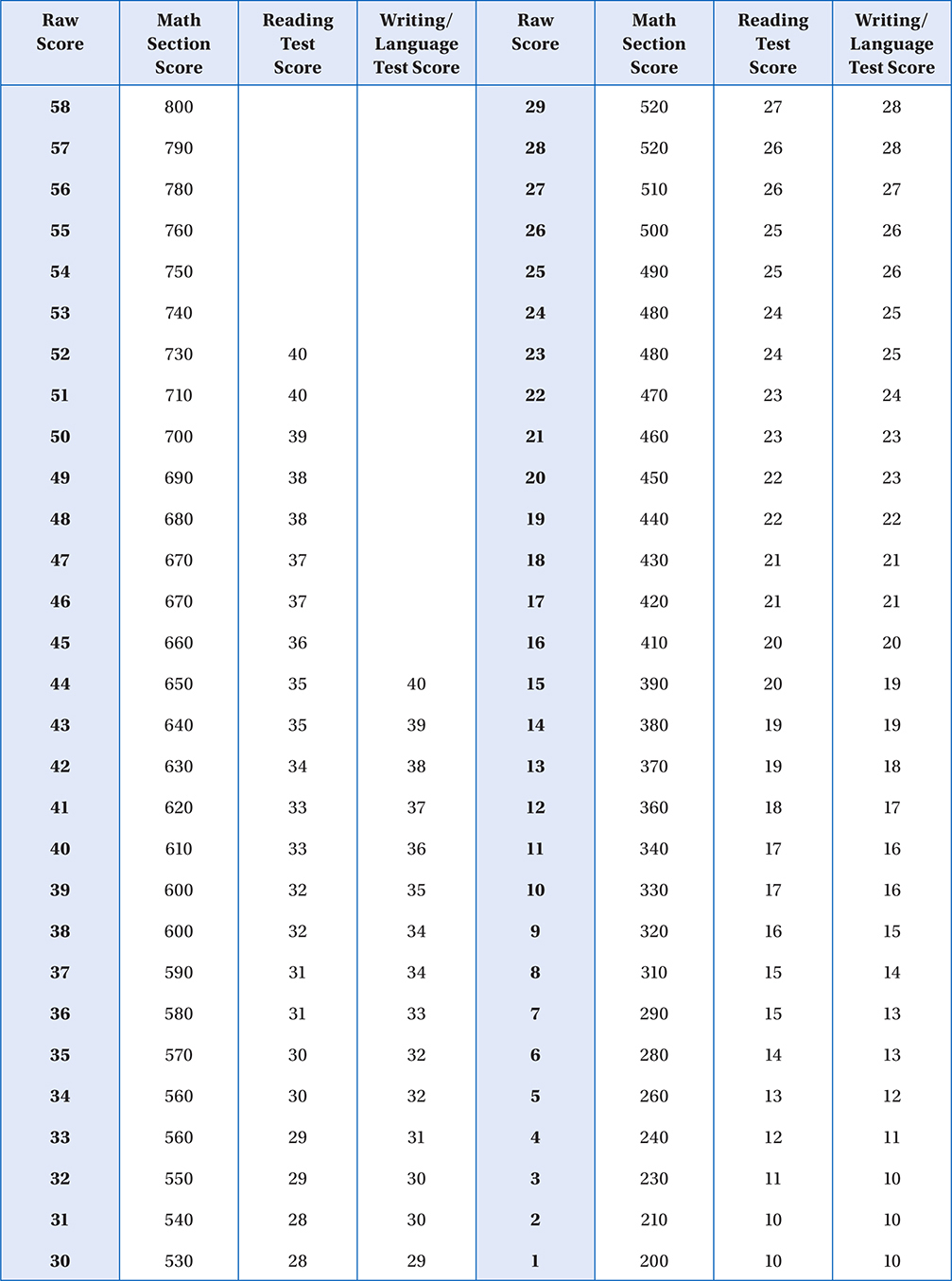
SAT PRACTICE TEST 2 DETAILED ANSWER KEY
Section 1: Reading
1. A
Tone
In the first paragraph, the author tells us that he has little prudence and no skill in inventing of means and methods … in adroit steering … nor in gentle repairing. He also has no skill to make money spend well. These are self-effacing descriptions. They are certainly not pontifical (speaking as a high priest), aspirational (expressing high hopes and goals), or sardonic (grimly cynical).
2. D
Inference
The statement that whoever sees my garden discovers that I must have some other garden is the last statement in the author’s list of his personal inadequacies. Therefore, this statement must be taken to be self-effacing as the other statements are, and specifically to mean that he lacks gardening skill.
3. C
Word in Context
Recall that the first paragraph begins with the question What right have I to write on prudence … ? The second provides a response to this question about his right: in saying I have the same title to write on prudence as I have to write on poetry or holiness, then, he is clearly saying that he has the standing or authority to write on prudence.
4. D
Inference
In following his declaration that he has the right to write on prudence (lines 13–14), Emerson states that [w]e write from aspiration as well as from experience. In other words, we gain the standing to write on prudence not only from expertise in prudent behavior, but also from a focused yearning.
5. B
Textual Evidence
As the explanation to the previous question indicates, the best support for this answer is in lines 13–14.
6. B
Specific Purpose
The sixth paragraph (lines 39–57) discusses three classes of people according to their proficiency in knowledge of the world (lines 39–40). The first class values health and wealth [as] a final good (lines 42–43). The second class values the beauty of the symbol (line 46–47). The third class lives above the beauty of the symbol to the beauty of the thing signified (lines 46–47). This last group has spiritual perception (line 49). Therefore, its members are superior for their ability to discern sublime qualities.
7. A
Interpretation
This phrase appears in a discussion of the individual who traverses the whole scale (line 50–51), that is, who has the skills of all three classes: practicality, taste, and spiritual perception. In saying that such a person does not offer to build houses and barns (lines 54) on the sacred volcanic isle of nature (lines 53–54), Emerson is saying that nature is merely a symbol that points to the splendor of God (55), and therefore not what a truly wise person chooses to fix his or her gaze upon. In other words, the building of houses and barns is an unwise allegiance to worldly things.
8. B
Word in Context
In saying that the world is filled with the proverbs and acts of a base prudence (lines 58–59), Emerson means that most of our actions and words are devoted to practical things, like the question will it bake bread (lines 64)? As Emerson made clear in his previous paragraph, these considerations are those of the lowest and least noble class, so theirs is an ignoble prudence.
9. C
Interpretation
As a whole, this paragraph discusses the problem that the world is filled with the proverbs and acts of a base prudence (lines 58–59), in other words, that our words and actions are too focused on a devotion to matter (lines 59–60) and its effect on our senses, as if we possessed no other faculties than the palate, the nose, the eye and ear (lines 60–61). Emerson describes this problem with a simile: this is a disease like a thickening of the skin until the vital organs are destroyed (lines 64–66). To Emerson, then, the disease is the problem of sensuousness (devotion to the senses rather than the intellect).
10. C
Characterization
In line 20, Emerson defines prudence as the virtue of the senses, but he regards the world of the senses [as] a world of shows (lines 22–23), that is false when detached (line 35) from the thing signified (line 47) by the natural, sensory, intellectual world, that is, from the splendor of God (lines 55). Furthermore, he says that prudence is a devotion to matter, as if we possessed no other faculties than the palate, the nose, the touch, the eye and ear (lines 59–61). Therefore, as a whole, the passage characterizes prudence as a pursuit of practical skills and sensory experience.
11. A
Tone
The opening paragraph describes this breathless pause at the threshold of a long passage (lines 8–9) in which the narrator and his crew seemed to be measuring our fitness for a long and arduous enterprise (lines 9–10). This describes the reflective anticipation of a journey. Notice that this description provides no evidence of anxiety or excitement. In fact, the scene is described in peaceful terms, with the ship very still in an immense stillness (line 2).
12. A
Specific Purpose
The narrator states that some glare in the air (lines 14–15) prevented him from seeing sooner something that did away with the solemnity of perfect solitude (lines 18–19). That is, he saw something that led him to believe they were not alone. In the next paragraph, this something is revealed to be the mastheads of a ship anchored inside the islands (lines 35–36).
13. C
Specific Detail
This sentence describes the scene as the narrator surveys the tide of darkness and a swarm of stars (lines 20–21) while resting his hand on the rail of the ship as if it were the shoulder of a trusted friend (line 24). In the next sentence, he describes this as a moment of quiet communion (line 26) with the ship, now interrupted by the sight of a strange ship beyond and the disturbing sounds (lines 27–28) being made by the crew. In other words, this sentence describes a moment of wistful (expressing vague longing) contemplation. Choice (A) is incorrect because, although the disturbing sounds and the omen of a distant ship may seem to be signs of impending danger, the sentence in lines 20–24 makes no mention of these things. Choice (B) is incorrect, because this moment is described as a moment of quiet communion, not deep inner turmoil. Choice (D) is incorrect, because there is no mention of any tragic experience.
14. A
Characterization
Since this story is being told from the perspective of the captain, we can infer his character from the nature of his narration. In the opening paragraph, the captain states that we seemed to be measuring our fitness for a long arduous enterprise, the point of our existences to be carried out (lines 9–12), demonstrating that he is more reflective than reactive as a leader. Much later he says, what I felt most was my being a stranger to the ship; and if all the truth must be told, I was somewhat of a stranger to myself … I wondered how far I should turn out faithful to that ideal conception of one’s own personality every man sets up for himself secretly (lines 56–66). These descriptions of reflection and self-doubt reveal the captain as being self-conscious and diffident.
15. D
Textual Evidence
As the explanation to question 14 shows, the best evidence for this answer can be found in lines 63–65.
16. C
Word in Context
In saying I mention this because it has some bearing on what is to follow (lines 55–56), the narrator means that the fact that he was the only stranger on board (line 54) is relevant to what he is about to say.
17. B
Word in Context
This sentence describes how the chief mate, described as earnest (line 71) and painstaking (72), is trying strenuously to figure out why there is another ship anchored nearby. In saying that he was trying to evolve a theory, the narrator means he is pondering (thinking) strenuously.
18. C
Specific Detail
The truth that the narrator mentions in line 57 is the fact that I am a stranger to myself. He later goes on to explain what he means by this: I wondered how far I should turn out faithful to that ideal conception of one’s own personality every man sets up for himself secretly (lines 63–66). In other words, this truth is the fact that he lacks self-confidence.
19. D
Word in Context
In saying that the why and the wherefore of that scorpion … had exercised him infinitely (lines 76–82), the narrator means that the chief mate was using his dominant trait … [of] earnest consideration (lines 71–72) to figure out how a scorpion had made its way into his cabin. That is, the questions about the scorpion had disquieted (unsettled) him infinitely.
20. D
Textual Evidence
The collaboration on the part of [the chief mate’s] round eyes and frightful whiskers (lines 67–68) describes his facial contortions as he deliberates about the anchored ship. In other words, it is an act of strained contemplation.
21. A
Interpretation
In the final line, the narrator says that the ship within the islands was much more easily accounted for. In other words, the scorpion was less easily accounted for, or less explicable.
22. C
Inference
The second paragraph discusses the “outsourcing” [of] the creation of human life (lines 8–9), so the design and control mentioned in line 13 refer specifically to the design and control of the process of conception.
23. B
Tone
The author of Passage 1 states that the “outsourcing” [of] the creation of human life … mocks the profundity of life (lines 8–12) and he provides no indication in the passage that he otherwise approves of it. Clearly, then, he regards it with blunt disdain.
24. D
Cross-Textual Analysis
Both of these quotations represent viewpoints with which the authors of the respective passages disagree. In Passage 1, the quotation “Sorry, but I think I can do better” (line 15) is from those who turn [their] noses up at the most precious gift in the universe (lines 13–14) much to the chagrin of the author. In Passage 2, the quotation “But you are playing God” (line 78) is described as the cry of all whose power is threatened by the march of human progress, and with whom the author clearly disagrees.
25. A
Cross-Textual Analysis
Jeremy Rifkin is described in Passage 2 as a cloning foe (line 63) who is quoted as saying “It’s a horrendous crime to make a Xerox of someone. You’re putting a human into a genetic straitjacket. ” Presumably, then, he would agree that our attitude toward the creation of life must be one of humility (lines 6–7).
26. D
Graphical Analysis
The illustration shows a schematic overview of some Therapeutic Cloning Strategies that involve removing a somatic cell from a patient and transferring its nucleus to stem cells that can then be cultured into genetically matched tissue that can then replace diseased cells and tissues in the patient. This is an example of one of the procedures to clone human cells for seemingly beneficial purposes (lines 39–40) described in Passage 1. Choice (A) is incorrect because the guided purpose refers to a principle of creationism, which is not indicated at all in the diagram. Choice (B) is incorrect because, although the process in the diagram might resemble an assembly line, it is not the assembly line that could be used to create a child that is no longer uniquely human (lines 23–24), but with carefully designed and tested features (lines 25–26). Choice (C) is incorrect because the diagram does not describe the course of human evolution, which would need to show how humans evolved from more primitive species.
27. D
Specific Meaning
The process of introducing degraded germs (line 53) describes the basic process of vaccination, which, like cutting flesh (line 52) (that is, surgery), must have seemed dangerous at first, but in fact can be a life-saving technology. This process is the injection of vaccines.
28. C
Inference
In this paragraph, the author of Passage 2 describes the position of cloning foes who believe that cloning is the end of evolution, or at least the beginning of its corporate management (lines 59–61). The author of Passage 1 is deeply concerned that the executive boards of these [cloning] companies will decide the course of human evolution, with more concern for quarterly profit reports than for the sake of humanity (lines 32–35). Clearly, then, the author of Passage 1 regards this management as a regrettable invasion of commercial interests into human reproduction.
29. A
Specific Purpose
Jeremy Rifkin’s belief that cloning is a horrendous crime (line 64) directly contradicts the thesis of Passage 2, which is that cloning and similar technologies can provide ample food for a starving world, cure devastating illnesses, and replace diseased organs (lines 98–100). Therefore, to the author of Passage 2, Rifkin’s opinion exemplifies an untenable (indefensible) position. Choice (B) may seem plausible, since Rifkin is warning of the potential dangers of cloning, but notice that this cannot be the reason that the author of Passage 2 quotes Rifkin, because the passage clearly disagrees with his sentiments.
30. C
Specific Purpose
The author of Passage 2 mentions the Twins Days Festival (line 68) in order to demonstrate the absurdity of Jeremy Rifkin’s statement that creating a genetic Xerox of a person is a horrendous crime (line 64). To the author of Passage 2, then, the Twins Days Festival represents the innocuousness (harmlessness) of genetic duplication, since twins are genetic duplicates, and nothing to be feared.
31. B
Cross-Textual Inference
The author of Passage 2 does not object to the procedures to clone human cells for seemingly beneficial purposes (lines 39–40), and in fact believes they are necessary contributions to medical progress since they potentially provide technologies to provide ample food for a starving world, cure devastating illnesses, and replace diseased organs (lines 98–100).
32. D
Textual Evidence
As the explanation to question 31 indicates, the best evidence for this answer is found in lines 95–100.
33. C
General Purpose
The first paragraph establishes that this passage is focused on the specific processes involved in children’s acquisition of language (lines 12–13). Therefore, the passage is primarily concerned with exploring academic questions about how we learn language. Choice (A) is incorrect because the passage does not begin to delineate the general principles of linguistics, which is a far greater subject than simply language acquisition. Choice (B) is incorrect, because although the passage does refer to children’s ability to acquire diverse languages like English … Bantu or Vietnamese (lines 63–64), it does not compare their structural qualities. Choice (D) is incorrect because, although the passage does discuss the ideas of the influential linguists Benjamin Whorf (in the second paragraph) and Noam Chomsky (in the last paragraph), these references only serve the larger purpose of exploring the questions of language acquisition, and do not serve as the overall focus of the passage.
34. C
Inference
In the first paragraph, the author indicates that [e]very time we speak we are revealing something about language, so the facts of language structure are easy to come by (lines 3–6). Therefore, the data mentioned in line 6 are the facts of language structure, which would likely include the syntax (rules governing word order) of different languages. Choice (A) is incorrect because information about literacy levels is not information about language structure. Choice (B) is incorrect because methods of teaching are not facts of language structure. Choice (D) is incorrect because, although the passage does mention the innate structure (line 59) of the brain a few paragraphs later, this is clearly not what line 6 is referring to.
35. B
Inference
The phrase the two (line 2) refers to two nouns in the previous clause: language and thoughts, in other words, thinking and expressing.
36. A
Word in Context
The author uses the phrase sticking communicable labels on thoughts (lines 15–16) to describe one particularly simplistic theory about the language acquisition. The author is using the metaphor of applying name tags or labels to describe one way of describing how words are used. Choice (B) is incorrect because upholding refers to a process of confirming an official claim or pronouncement. Choice (C) is incorrect because, although sticking (as with a needle) can mean piercing, this reference clearly does not imply any act of puncturing. Choice (D) is incorrect because this phrase describes an act of acquisition, that is, learning something new, rather than maintaining something old.
37. D
Tone/Attitude
After describing Benjamin Whorf’s theory, the author then states that virtually all modern cognitive scientists believe it is false (lines 25–27). The author’s ensuing discussion makes it clear that he agrees with these cognitive scientists. That is, he is antagonistic toward Whorf’s hypothesis. Choice (A) is wrong because the author does not dismiss Whorf’s hypothesis, but rather regards it as an intriguing hypothesis which just happens to be incorrect. (To dismiss an idea is to believe it is not even worthy of consideration, not merely to reject it after consideration.) Choice (B) is clearly wrong because the author does not support Whorf’s hypothesis. Choice (C) is wrong because the author does not have any conflicting feelings about the hypothesis.
38. B
Interpretation
The author states that babies can think before they can talk (line 27) in order to refute Whorf’s hypothesis that we can’t think in terms of categories and relations (line 19) until our language gives us the words to do so. Whorf believes that language precedes thought. The author of this passage is saying the opposite: that skills associated with basic reasoning are not dependent on verbal communication.
39. C
Thesis
The author’s view on human language acquisition can be found in lines 95–97: language acquisition depends on an innate, species-specific module that is distinct from general intelligence. This module must have an intricate innate structure (line 59) in order to acquire a language that is itself intricately complex (line 55). Choice (A) is incorrect because it represents the Whorf hypothesis, which the author explicitly rejects. Choice (B) is incorrect because the author does not state that the structures for learning language are simple. Choice (D) is incorrect because the author places more emphasis on the innate structure in the brain that enables language acquisition than he does on environmental input.
40. D
Textual Evidence
As the explanation to question 39 indicates, the best evidence for this answer is found in lines 95–97.
41. B
Interpretation
Lines 58–64 discuss the author’s belief that the innate structure in the brain dedicated to language acquisition cannot be either too simple or too complex. This kind of structure refers to the functional organization of the mind. Notice that the structure being discussed here is not the same as the structure mentioned in line 5, which refers to the structure of language itself.
42. A
Inference
The author states that, in 1959, Anglo-American natural science, social science, and philosophy had come to a virtual consensus about the answers to the questions listed above (lines 78–81), that is, the questions listed in lines 14–17: Is language simply grafted on top of cognition as a way of sticking communicable labels on thoughts? Or does learning a language somehow mean learning to think in that language? The consensus on these topics was that language must be learned; it cannot be a module; and thinking must be a form of verbal behavior (lines 85–87) Therefore, the disciplines accepted the hypothesis that cognition depends on verbal skills.
43. B
General Purpose
The passage begins by saying our negative view of scavengers ignores an important fact: scavenger relationships are essential to all complex life (lines 10–12). The second paragraph describes how scavenger behavior drives social intelligence, as with dogs. The third describes how decomposers break down petroleum and plastics in the environment. The fourth discusses how scavenger bacteria in the human gut help to regulate our bodily systems. As a whole, then, the passage serves to explore various ways in which scavengers can be beneficial to different ecosystems that are relevant to humans. Choice A is wrong because the passage does not discuss ways of preserving ecosystems. Choice C is wrong because social intelligence is only discussed in the second paragraph. Choice D is wrong because the passage does not discuss ways of avoiding the diseases that [scavengers] spread.
44. D
Word in Context
Since the previous paragraph discussed the evolution of social intelligence (line 14) among scavengers like the grey wolf, and their evolution into friendly Frisbee-fetchers (lines 31–32), the phrase perspicacious scavengers is referring to those scavengers that can develop mutually beneficial social relationships.
45. C
Graphical Inference
The graph shows how much U.S. plastic is going into the environment, such as oceans and landfills, rather than being recycled. In lines 55–64, the passage discusses the ability of Aspergillus tubingensis to break down polyester polyurethane, a petroleum product and one of the more durable plastics in our landfills and ocean. Since plastics are a food source for A. tubingensis, the graph is appropriate to a discussion of the habitat of Aspergillus tubingensis.
46. C
Inference
In lines 15–20, the passage says that some scavenger species have struggled to outwit the wily hunters with whom they compete for scraps … in order to avoid becoming the next prey. Choice A is wrong because tracking prey is a hunter behavior, not a scavenger behavior. Choice B is wrong because the passage does not discuss how scavengers might find more nutritious food sources. Choice D is wrong because, although the passage does state that hunters like Homo sapiens had to become more clever to protect their meat from these thieves (lines 20–22), this is an intelligent behavior of hunters, not scavengers.
47. B
Textual Evidence
As the explanation to question 46 indicates, the best evidence for this answer can be found in lines 17–20.
48. A
Word in Context
A process of break[ing] down complex molecules into simpler ones (lines 41–42) implies that the original molecules are larger and more intricate than they will become. Choice B is wrong because obscure and bewildering do not describe physical properties. Choice C is wrong because the passage does not imply that these molecules are delicate; they just need a special process to break them down. Choice D is wrong because unfathomable does not describe a physical property.
49. C
Word in Context
The phrase encourage this biodegradation (line 52) means do something to invigorate the process. Choices A, B, and D are all incorrect because inspire, goad, and persuade are verbs that can only be applied to people, not chemical processes.
50. C
Detail
In lines 60–63, the passage indicates that environmentalists have yet to discover a practical method for harnessing A. tubingensis in large-scale waste mitigation systems, which means that these microorganisms are not easily controlled.
51. D
Textual Evidence
As the explanation to question 50 indicates, the best evidence for this answer is found in lines 60–64.
52. A
Purpose
The final paragraph discusses how scavenger bacteria in the human gut help to keep things running smoothly (lines 72–73), specifically by maintaining our digestive processes, blood pressure, and immune system (lines 66–67). Choice B is wrong because the paragraph cautions against the overuse of antibiotics, but does not discuss how to develop them. Choice C is wrong because the paragraph discusses benefits of bacteria, not dangers. Choice D is wrong because although this paragraph cautions against overusing antibiotics, it does not say that it is due to any fear of bacteria.
Section 2: Writing and Language
1. A
Idiom
The original phrasing is best. Choice (B) is incorrect because choice with getting is not idiomatic. Choice (C) is incorrect because choice of the way is not idiomatic. Choice (D) is incorrect choice of getting, although idiomatic conveys an illogical idea in this context.
2. C
Diction
Here we are asked to choose the best word to convey the appropriate idea in this sentence. The sentence indicates that we might be surprised to learn something about the world of journalism, and hence that most of us are not as informed about the world of journalism as we could be. In other words, we are not particularly savvy (knowledgeable) about the world of journalism. Apt = suitable to the circumstances; acute = sharp; comprehensive = complete.
3. B
Diction/Logic
In the original phrasing, the pronoun which is illogical, since it refers to the media: that is, saying the media is 90% does not make sense. Choice (C) is incorrect because the phrase all 90% of it is illogical: all of it means 100% of it. Choice (D) is incorrect because it is both unidiomatic and illogical.
4. C
Possessive Form/Pronoun Agreement
In the original phrasing, the pronoun their disagrees with its antecedent corporation, which is singular. Recall that the possessive form of the pronoun it is its (it’s = it is). The only choice that avoids both the agreement error and the diction error is (C).
5. B
Parallelism
This phrase should be parallel to the subject-verb pair in the previous sentence, Some argue. The only choice with a parallel verb form is (B).
6. A
Data Analysis
The original phrasing is the only option that represents the data in Figure 1 accurately. Since the second circle graph represents all broadcast television media and its ownership, it indicates that 3.2% (0.6% + 1.3% + 0.9% + 0.4%) of American broadcast television outlets were controlled by minorities.
7. D
Idiom
The idiomatic form of this phrase is antidote to.
8. C
Clear Expression/Pronoun Antecedents
In choices (A), (B), and (D), the pronoun it lacks any clear referent. The only choice that avoids this problem is (C).
9. B
Cohesiveness/Purpose
Examples that contrast civilized debate would have to be examples of uncivilized debate. Gossip and fear-mongering certainly qualify as relatively uncivilized and unsophisticated forms of discourse.
10. B
Idiom, Pronoun-Antecedent Agreement
Here, we are looking for the most appropriate logical transition from the previous paragraph to the new one. The last sentence of the previous paragraph gave examples of in-depth, nonprofit, public-supported journalism that is less influenced by any corporate or political agenda. The new paragraph, however, begins with a discussion of sensationalism and how it sells, which provides a stark contrast to the previous paragraph. This requires a contrasting coordinator, such as nevertheless or still.
11. D
Diction/Clear Expression of Ideas
We want a word to represent the websites like ProPublica and NPR, as mentioned in the previous paragraph, that engage in relatively noncorporate and apolitical journalism. The phrase instances of journalism indicates specific articles or broadcasts, rather than the organizations themselves. The phrase patterns of journalism indicates trends in those articles or broadcasts, rather than the organizations themselves. The phrase receptacles of journalism indicates containers that receive journalism rather than organizations that produce it. Only (D) repositories of journalism provides a phrase that refers to the organizations themselves.
12. D
Coordination/Verb Tense
The original phrasing creates a sentence fragment rather than an independent clause. Choice (B) is incorrect because it commits the same error. Choices (C) and (D) both form independent and idiomatic clauses, but choice (C) is incorrect because the sentence is clearly making a claim about the current state of being of these rituals, rather than the current status-as-consequence of these rituals, so the present perfect (or “present consequential”) form is not appropriate. (For more on using the “perfect” or “consequential” aspect, see Chapter 4, Lesson 23.)
13. A
Coordination/Conjunctions
The original phrasing is best. Choice (B) is incorrect because the second clause does not explain the first. Choice (C) is incorrect because the second clause does not follow as a consequence of the first. Choice (D) is incorrect because there is no tonal or semantic contrast between the clauses.
14. B
Diction/Clear Expression of Ideas
The phrase collide against is not idiomatic: collide with is the correct idiom, although this phrase would imply more of a physical relationship than the sentence intends. Since the sentence indicates a conflict between an event and a belief so the verb should express a relationship between ideas, rather than objects. Of the choices, only (B) contradict serves this purpose effectively.
15. C
Coordination
In this sentence, the conjunction and establishes the relationship between the coordinate independent clauses, so any subordinating conjunction like since, so, or because is inappropriate.
16. B
Diction, Agreement
Colons must always follow independent clauses, so choices (A) and (D) are incorrect. This phrase must provide a definition of the term “agency,” which is precisely what choice (B) that is, intentional action does. Choice (C) is incorrect because it categorizes rather than defines.
17. D
Parallelism
This sentence presents a list of present tense verbs: design … compose … and formulate. The original phrasing is incorrect because it reinserts the auxiliary can, which breaks the parallel structure of the list. Only choice (D) maintains this parallel form.
18. D
Cohesiveness
This sentence belongs before sentence 5, because it provides a parallel idea to the one presented in sentence 4. Sentence 4 states that Many of these [superstitions] are harmless if not quaint, so the next sentence should provide a transition to some of the less pleasant aspects of superstitious thinking.
19. C
Pronoun-Antecedent Agreement/Verb Mood
In the original phrasing, the pronoun it does not agree with its plural antecedent explanations; therefore, choices (A) and (B) are incorrect. Choice (D) is incorrect because the auxiliary would implies necessity, rather than ability, which is illogical in this context.
20. B
Clear Expression/Pronoun Antecedents
The original phrasing is incorrect because the two instances of the pronoun their have conflicting antecedents, and the second clause is needlessly in the passive voice. Choices (C) and (D) have similar pronoun referent problems. Only choice (B) is phrased without ambiguous pronouns.
21. D
Diction
The previous sentence, as well as the passage as a whole, indicates that superstitious rituals are used to satisfy a craving in our brains for control.
22. A
Cohesiveness
Only choice (A) maintains the skeptical and analytical tone toward superstitious rituals that is established in the rest of the passage.
23. C
Clear Expression
The original phrasing is incorrect because the phrase debating a warming planet is illogical: only theories, claims, or ideas can be topics of debate. Choices (B) and (D) are incorrect because the clause if we should lacks a logical object.
24. D
Comma Splices/Coordination
The original phrasing is incorrect because it creates a comma splice. Two independent clauses may not be joined by only a comma. Choice (B) is incorrect because the conjunction while is illogical. Choice (C) is incorrect because it forms a noun phrase, which does not coordinate with any part of the main clause. Choice (D) creates a participial phrase that appropriately modifies the subject of the main clause.
25. C
Clear Expression/Idiom
In the original phrasing, the verb provide is used illogically and the phrase cost of the American taxpayer is unidiomatic. Choice (B) is incorrect because needless in costing is unidiomatic. Choice (D) is incorrect because the verb is disagrees in number with its subject attempts.
26. A
Diction
The original phrasing is best. The verb is serves most effectively in the role of defining science.
27. B
Parallelism
The underlined phrase is the third item in a parallel list: identifying … gathering … and finding. Choice (B) best maintains this parallel structure without introducing any other error. Choice (D) provides a parallel form, but the phrase way for explaining is unidiomatic.
28. DParallelism
The underlined phrase is part of a parallel list: that the earth … that the effects … that there are things … and that many of these things … Only choice (D) maintains this parallel structure.
29. A
Logical Cohesiveness
The original phrasing best, since the passage is about eliminating politics and ideology from discussions about climate change. The other choices insert points of advocacy that conflict with the tone and purpose of the passage as a whole.
30. D
Clear Expression of Ideas/Verb Mood/Verb Tense
The original phrasing includes an illogical core: the fact … isn ’t the same as it being true. Choice (B) is incorrect because a statement of general fact should not be in the future tense. Choice (C) is incorrect because a statement of general fact should not be in the subjunctive mood. Choice (D) uses the idiom make it so logically and grammatically.
31. A
Parallelism
The original phrasing is the only option that completes the parallel construction caused not by germs … but by demons.
32. A
Verb Form/Clear Expression
The original phrasing is the most logical and concise.
33. C
Logical Coherence
The adverb furthermore indicates that this sentence is extending a line of reasoning. Since it clearly follows the parallel clauses of sentence 2, When we … become … we become … and therefore it most logically follows sentence 2 but precedes sentence 3.
34. C
Pronoun Agreement/Verb Aspect
The original phrasing is incorrect because the pronoun they disagrees in number with the antecedent Bohemia. Choice (B) is incorrect because it produces a comma splice. Choice (D) is illogical because the use of the present perfect participle having been improperly implies a consequence.
35. D
Diction
The original phrasing is illogical because a country cannot regard (consider in a particular way; concern) anything. This verb must show a relationship between a particular country and a particular geographical region. Only choice (D) comprises (makes up) expresses this relationship in a logical way.
36. B
Coordination
The original phrasing is incorrect because it creates a dangling participle: the participle designating does not share its subject with the main clause. Choice (C) is incorrect because it creates a comma splice. Choice (D) is incorrect because it also creates a dangling participle. Choice (B) is best because it avoids both the comma splice and dangling participle.
37. B
Verb Tense/Verb Aspect
The phrase by 1843 indicates that the status of the term Bohemian had become established prior to that point in time. Therefore, the verb requires the past perfect or past consequential form: had come to mean. Although choice (D) is a verb in the past consequential form, it incorrectly implies that the term no longer had that particular meaning in 1843.
38. A
Coordinating Modifiers
This sentence is trying to convey the fact that [La Vie de Bohème] proved [to be so] extraordinarily successful that the stories themselves were published. This requires the active voice, so choices (B) and (C) are incorrect. Choice (D) is incorrect because it is unidiomatic.
39. D
Number Shift
The original phrasing is incorrect because of the number shift between it and elements. Choices (B) and (C) are needlessly wordy. Choice (D) is clear and concise.
40. C
Diction/Logical Coherence
This sentence indicates the effect that increased commodity production had on the commercial middle class. It is illogical to say that the middle class propagated (was transmitted), propitiated (won the favor of someone), or preempted (took action to prevent something) as a result of this increased production. It is, however, logical to say that the middle class prospered (flourished) as a result of it.
41. A
Coordination of Clauses
The original phrasing best coordinates the two related, but independent, clauses. Choice (B) produces a run-on sentence with a comma splice. Choice (C) is illogical and unidiomatic. Choice (D) is illogical and misuses the semicolon.
42. B
Clarity of Expression/Parallelism
Choice (B) provides the most parallel comparison: the production of art was in fact less important than the capacity for art.
43. D
Coordination of Ideas
The use of the adverb thus indicates that this sentence represents a logical consequence of some particular state of affairs. That state of affairs is best indicated by sentence 5: Most of its ingredients had existed in Paris for at least two decades before he started writing. This explains why Murger can be described as a Bohemian of the second generation.
44. C
Coherence/Meaning
This question is essentially asking us to describe the function of Claretie’s quotation. Since it refers to a poisonous element in the French character, it is clearly indicating a dire assessment of France’s national temperament.
Section 3: Math (No Calculator)
1. B
Algebra (solving equations) EASY

2. B
Special Topics (circles) EASY
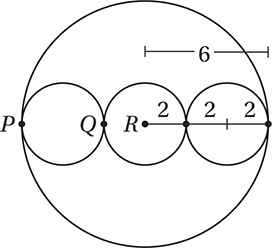
Marking up the diagram with the given information, as shown, shows that three of the smaller radii make up one larger radius. Therefore, the radius of each small circle is 6/3 = 2.
3. C
Algebra (word problems/fractions) EASY
If 1/5 of her term paper is 15 pages, then the entire paper must be 15 ´ 5 = 75 pages long. This means she has 75 - 15 = 60 more pages to edit.
4. C
Advanced Mathematics (functions and sequences) EASY
Notice that the rule in choice (C) generates the entire sequence: 7 (times 2 minus 2 equals) 12 (times 2 minus 2 equals) 22 (times 2 minus 2 equals) 42 (times 2 minus 2 equals) 82.
5. B
Special Topics (three dimensional geometry) MEDIUM
Notice that the question asks us for the longest length of a diagonal on one of the faces of the box, and that there are three different rectangles as faces: a 3 ´ 4 rectangle, a 3 ´ 5 rectangle, and a 4 ´ 5 rectangle. Clearly the one with the two greatest dimensions will have the longest diagonal, which we can find using the Pythagorean Theorem.

6. A
Algebra (linear equations) MEDIUM
We can test each point to find the one that does NOT satisfy the equation.
(A) -2(-9) - 3(6) = 18 - 18 = 0 ≠ 36
(B) -2(-24) - 3(4) = 48 - 12 = 36
(C) -2(6) - 3(-16) = -12 + 48 = 36
(D) -2(12) - 3(-20) = -24 + 60 = 36
Therefore, the correct answer is (A).
7. A
Advanced Mathematics (parabolas) MEDIUM
The initial population, I, is the population when the time is 0. Therefore, I = 250(1.32)0 = 250(1) = 250. The annual percent increase in the population, r, can be calculated by finding the population at t = 1 and then calculating the percent change from the initial population. If t = 1, P = 250(1.32)1. As we discussed in Chapter 8, Lesson 7, multiplying a quantity by 1.32 is equivalent to increasing a number by 32% (that is, 1.32 = 100% + 32%), so r = 32%.
8. A
Advanced Mathematics (rational expressions) MEDIUM
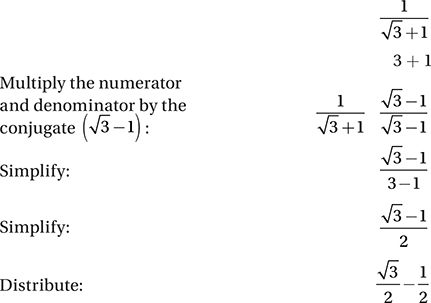
9. B
Algebra (linear relationships) MEDIUM
As we discussed in Chapter 7, Lesson 5, a line in the form ax + by = c has a slope of -a/b. Therefore, the line 3x + 6y = 0 has a slope of -3/6 = -1/2. Recall, also, from Chapter 7, Lesson 7, that perpendicular lines have slopes that are opposite reciprocals. Therefore, the line we are looking for must have a slope of 2. You might draw a quick sketch of the xy-plane and plot the points given in each choice to find the line that has a slope of 2, or you could use the slope formula from Chapter 7, Lesson 5: slope = (y2 - y1)/(x2 - x1).
(A) slope = (3 - 0)/(0 - (-6)) = 3/6 = 1/2
(B) slope = (-6 - 0)/(0 - 3) = -6/-3 = 2
(C) slope = (6 - 0)/(0 - 3) = 6/-3 = -2
(D) slope = (3 - 0)/(0 - 6) = 3/-6 = -1/2
The only choice that gives a slope of 2 is (B).
10. B
Advanced Mathematics (quadratics) HARD
Perhaps the simplest way to begin this problem is to draw a quick sketch of the function in the xy-plane, and then compare this graph to the transformations of the original function given in the choices. Notice that the original function f(x) = x - x2 is easily factored as f(x) = x (1 - x). The Zero Product Property (Chapter 9, Lesson 5) tells us that this function must have zeros at x = 0 and x = 1. Notice, also, that since the coefficient of the x2 term in the original function is negative (-1), the graph of this quadratic is an “open-down” parabola. Also, the axis of symmetry is halfway between the zeros, at x = ½. Plugging x = ½ back into the function gives us  , and therefore, the vertex of the parabola is
, and therefore, the vertex of the parabola is  .
.
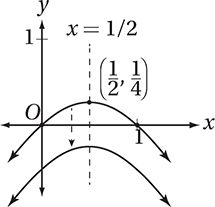
The question asks us to find the function that has no real zeros. This means that the graph of this function must not intersect the x-axis at all. Each answer choice indicates a different transformation of the function f. Recall from Chapter 9, Lesson 3, that choice (A) f(x) + ½ is the graph of f shifted up ½ unit, choice (B) f(x) - ½ is the graph of f shifted down ½ unit, choice (C) f(x/2) is the graph of f stretched by a factor of 2 in the horizontal direction, and choice (D) f(x - ½) is the graph of f shifted right ½ unit. As the sketch above shows, only (B) yields a graph that does not intersect the x-axis.
11. D
Advanced Mathematics (polynomials) MEDIUM-HARD
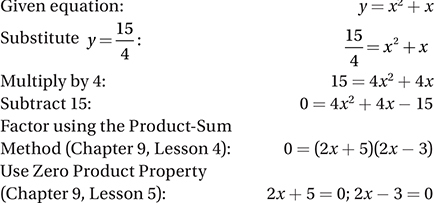
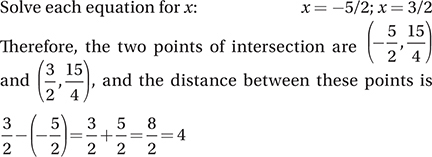
12. D
Special Topics (complex numbers) MEDIUM-HARD
Recall from Chapter 10, Lesson 10, that in = 1 if and only if n is a multiple of 4. (If you need refreshing, just confirm that i4 = 1, i8 = 1, i12 = 1, etc.) Therefore, if i2k = 1, then 2k must be a multiple of 4, and therefore, k must be a multiple of 2. If k is a multiple of 2, then k/2 must be an integer. Choice (A) is incorrect, because k = 2 is a solution, but 2 is not a multiple of 4. Choice (B) is incorrect because k = -2 is a solution, and -2 is not a positive integer. Choice (C) is incorrect because k = 2 is a solution, but when 2(2) = 4 is divided by 4, the remainder is 0, not 1.
13. B
Algebra (absolute values) MEDIUM-HARD
In order to minimize the value of |22 - x2 - y2| + 22, we must minimize the absolute value. But the least possible value of any absolute value expression is 0, so we must ask: is it possible for the expression inside the absolute value operator to equal 0? A little trial and error should reveal that it can if, for instance, x = 2 and y = 0. Notice that this gives us |2 - 22 - 02| + 2 = |0| + 22 = 4. Since the absolute value cannot be less than 0, this must be the minimum possible value.
14. C
Advanced Mathematics (analyzing polynomial functions) HARD
The simplest polynomial with factors of 12, (x - 5), and (x + 4) is P(x) = 12(x - 5)(x + 4). The completely factored form (including the prime factorization of the coefficient) of this polynomial is P(x) = (2)2 (3)(x - 5)(x + 4).
Now, using the methods we discussed in Chapter 9, Lesson 4, we can look at the factored form of each choice:

Notice that every polynomial in (A), (B), and (D) contains at least one factor that is NOT in the factored form of P(x). (In (D), the factor (x - 5) appears twice, but it appears only once in P(x).) Only choice (C) contains ONLY factors that appear in P(x), so it is the only choice that must be a factor of P(x).
15. D
Advanced Mathematics (functions) HARD

16. 8
Algebra (ratios/word problems) EASY
Let x equal the number of men in the workshop. If there are half as many men as women, there must be 2x women

As with all algebra problems, make sure you confirm that the value you’ve solved for is the value the question is asking for. Since x is in fact the number of men, it is the final answer.
17. 2/3 or .666 or .667
Advanced Mathematics (rational equations) EASY
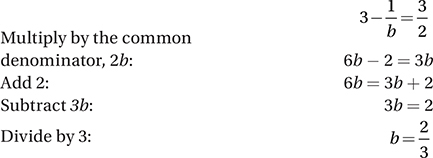
18. 1.2 or 6/5
Algebra (word problems) HARD

19. 5/2 or 2.5
Advanced Mathematics (quadratics) MEDIUM-HARD
Using the Factor Theorem from Chapter 9, Lesson 7, we know that if a quadratic has zeroes at x = 1 and x = 5, it must have factors of (x - 1) and (x - 5). Since a quadratic can only have two linear factors, f must be of the form f(x) = k(x - 1)(x - 5).
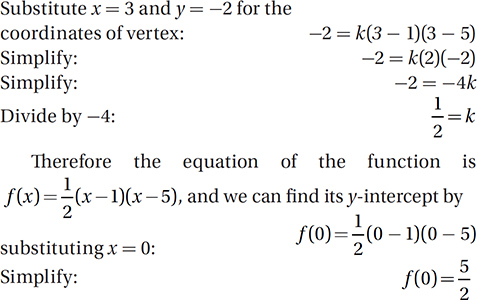
20. 7/3 or 2.33
Special Topics (trigonometry) HARD
The graph of the line y = mx - 4 has a slope of m and a y-intercept of -4. Since m > 0, this slope is positive. We are told that this line intersects the x-axis at an angle of θ, where cos  . This gives us enough information to sketch a fairly detailed graph:
. This gives us enough information to sketch a fairly detailed graph:
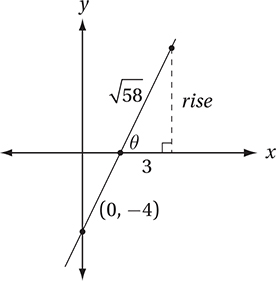
Notice that this information lets us construct a right triangle that includes q, in which the adjacent side has length 3 and the hypotenuse has length  (remember cos θ = adjacent/hypotenuse). This triangle is particularly handy because it depicts the rise and the run for a portion of the line, which will enable us to find the slope. We simply have to find the rise with the
(remember cos θ = adjacent/hypotenuse). This triangle is particularly handy because it depicts the rise and the run for a portion of the line, which will enable us to find the slope. We simply have to find the rise with the

Section 4: Math (Calculator)
1. B
Algebra (systems) EASY
Since the question asks for the value of b, it makes sense to substitute for a so that we get a single equation in terms of b.

2. B
Data Analysis (central tendency) EASY
The table summarizes the following list of 20 numbers: 1, 1, 1, 2, 2, 2, 2, 3, 3, 3, 5, 6, 7, 8, 8, 8, 9, 10, 10, 10. If a set of numbers is listed in increasing order, the median is the middle number (if the set contains an odd number of elements) or the average of the two middle terms (if the set contains an even number of elements). The median of a set of 20 numbers, therefore, is the average of the 10th and 11th terms. Since the 10th number is 3 and the 11th number is 5, the median is (3 + 5)/2 = 4.
3. A
Problem Solving/Data Analysis (proportions) EASY

4. C
Data Analysis (tables) EASY
The ratio of applicants to finalists is simply the quotient of those two values, which we can calculate for each year.
(A) 8/25 = 0.32,
(B) 8/26 » 0.31,
(C) 9/23 » 0.39,
(D) 10/26 » 0.38.
5. D
Algebra (exponentials) EASY
Although solving for y and z isn’t hard, it is even simpler to just express (yz)6 in terms of y3 and z2, using the Laws of Exponentials from Chapter 9, Lesson 9.

6. A
Algebra (word problems) EASY
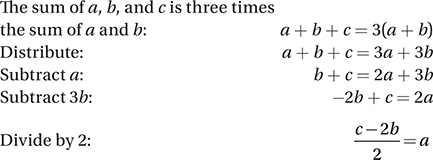
7. A
Advanced Mathematics (triangle trigonometry) EASY
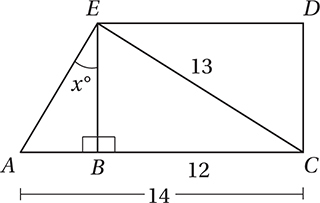

8. A
Advanced Math (quadratics) EASY
We can factor this quadratic easily with the Product-Sum Method from Chapter 9, Lesson 4.
x2 - 6x + 8 = (x - 4)(x - 2)
9. A
Data Analysis (pie graph) MEDIUM
Since Maria’s sales accounted for 25% of the total, her sector must be 0.25(360°) = 90°, which is sector D. This means that Eli ($3,000), Georgia ($5,000), and Zoe ($10,000) account for sectors A, B, and C. Since Georgia’s total is between Eli’s and Zoe’s, her sector is the neither the largest nor the smallest of the remaining sectors. Therefore, it must be sector A, which is in the middle.
10. B
Data Analysis (pie graph) MEDIUM
Perhaps the simplest way to approach this is to notice that, since Maria’s sales account for 25% of the total, the other salespeople must account for 100% - 25% = 75% of the total. Since this total is $3,000 + $5,000 + $10,000 = $18,000, we can find the total with a proportion.

11. D
Data Analysis (pie graph) MEDIUM
Since Maria accounted for 25% of the total sales, she accounted for (0.25)($24,000) = $6,000 in sales. If she earned 15% commission for all sales, she earned (0.15)($6,000) = $900 in commissions. If Georgia earns 10% in commissions, she earned (0.10)($5,000) = $500. Therefore, Maria earned $900 - $500 = $400 more in commissions that Georgia did.
12. B
Algebra (absolute value) MEDIUM
The function f(x) = 2 - |x - 4| reaches its greatest value when the absolute value is minimized. Since absolute values cannot be negative, the least value |x - 4| can have is 0, which it has when x = 4:
f(4) = 2 - |4 - 4| = 2 - 0 = 2
13. C
Advanced Math (rational equations) MEDIUM
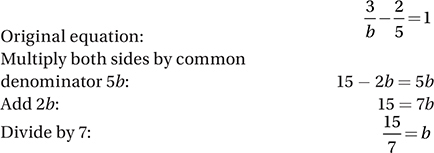
14. D
Advanced Mathematics (functions) MEDIUM
(A) f(1) = 12 + 3 = 4; f(2) = 22 + 3 = 7
(B) f(1) = 12 + 9 = 10; f(2) = 22 + 9 = 13
(C) f(1) = 2(1)2 + 2 = 4; f(2) = 2(2)2 + 2 = 10
(D) f (1) = 3(1)2 + 1 = 4; f(2) = 3(2)2 + 1 = 13
The only function that satisfies the two given equations is (D).
15. A
Advanced Mathematics (exponentials) MEDIUM
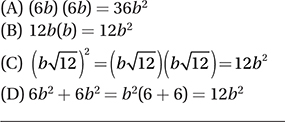
16. C
Data Analysis (probability) MEDIUM
One way to represent this problem clearly is to construct a table that shows all of the possible products mn. A representation of all the equally likely possible outcomes of an event is called the sample space for that event. We can label the columns with the possible values of m and the rows with the possible values of n. As we write in the products, let’s shade in those that are multiples of 12.
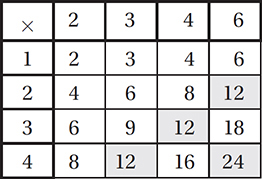
This shows that 4 out of the possible 16 products are multiples of 12, and therefore, the probability is 4/16 or .
17. B
Algebra (inequalities) MEDIUM

18. B
Advanced Mathematics (functions) MEDIUM-HARD
Since the function takes “all values of x,” one way to solve this problem is to choose a value of x to work with, like x = 1.
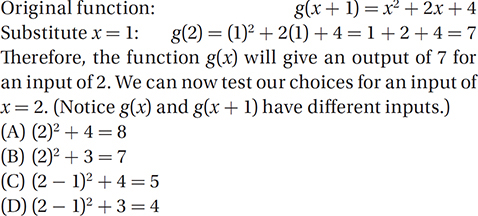
Notice that only the expression in (B) gives the correct output.
19. C
Advanced Mathematics (sequences) MEDIUM-HARD
The “brute force” method is to write out sequence A until you reach 72, and see which element in sequence B “matches up” to it. But first we must determine the rule for each sequence. A little guessing and checking should confirm that sequence A follows the “add 5” rule, and sequence B follows the “add 10” rule.
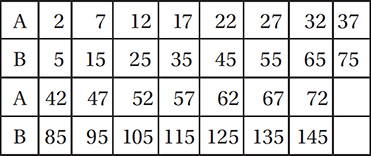
A more elegant method, however, is to find the formulas for the nth term of A and the nth term of B. This would be a much more efficient method, also, if it takes a while for 72 to appear in set A. If you recall the general formula for the nth term of an arithmetic sequence (an = a1 + (n - 1)d), then it’s straightforward to see that the formula for A is an = 2 + (n - 1)5 = 5n - 3 and the formula for B is bn = 5 + (n - 1)10 = 10n - 5. Since we’re looking for where the number 72 appears in set A, we can solve 5n - 3 = 72 to find n = 15, then insert this value for n into the formula for B: b15 = 10(15) - 5 = 145.
20. C
Problem Solving and Data Analysis (ratios) MEDIUM
If the ratio of subscribers to nonsubscribers is 2:5, then we can say there are 2n subscribers and 5n nonsubscribers, where n is some integer. This means there were a total of 2n + 5n = 7n July visitors to the website. Since we know that there were 2,100 visitors in July, we

Therefore, there were 2(300) = 600 subscriber visits and 5(300) = 1,500 nonsubscriber visits, and so there were 1,500 - 600 = 900 more nonsubscribing visitors than subscribing visitors.
21. A
Algebra (graphing lines) MEDIUM-HARD
In quadrant I, both the x- and y-coordinates are positive. Since y = 4 in all four systems, we simply need to find the system for which the x-coordinate of the solution is not positive. We can find the corresponding x-coordinate for each system by just substituting y = 4 and solving for x.

In this case, we don’t need to go any further, because the solution to the system in (A) is (-5/3, 4), which is in quadrant II, not quadrant I.
22. D
Advanced Mathematics (quadratics) MEDIUM-HARD
Read the question carefully, and note particularly what it is asking for and what information can help you find it. We are asked to find an equation to relate two variables, q, the number of power units, and t, the number of hours the battery has been charging. We are told that the initial charge is 20 power units, so q = 20 when t = 0. We are also told that the charge increases from 50 power units to 106 power units in 40 minutes. But since our time unit t is in hours, we should convert 40 minutes to 40/60 = 2/3 hours. Therefore, the charging station charges at a rate of (106 - 50)/(2/3) = (56)/(2/3) = 84 charging units per hour. This unit rate is the slope of the line, as we discussed in Chapter 8, Lesson 5. Therefore, the equation should represent a line with slope of 84 that contains the point t = 0 and q = 20, which is the equation in (D) q = 84t + 20.
23. C
Data Analysis (scatterplots) EASY
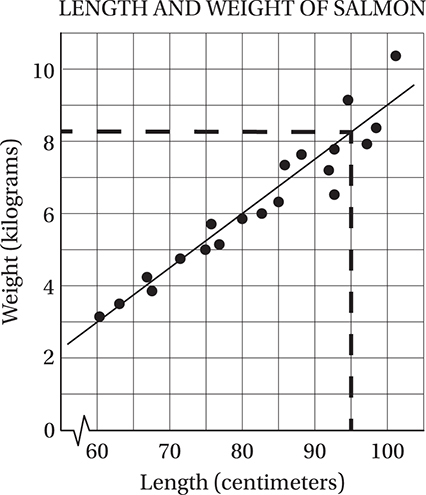
This question simply asks us to find the point on the line of best fit that corresponds to a length of 95 centimeters. As the dotted lines show below, this corresponds to a weight less than halfway between 8 and 9 kilograms, so (C) 8.3 is the best approximation among the choices.
24. D
Data Analysis (scatterplots) HARD

To find the equation of the line of best fit, we can take two points on the line and then use the point-slope formula (Chapter 7, Lesson 5) to find the equation of the line. To get the most accurate representation of the line, we should choose two points that are fairly far apart, but whose coordinates are easy to determine. The graph shows that this line appears to pass through the points (60, 3) and (100, 9), and so, by the slope formula (Chapter 7, Lesson 5) we can calculate that the slope is (9 - 3)/(100 - 60) = 6/40 = 3/20. Using the first point in the

25. B
Problem Solving (rates) MEDIUM
If Ronika plans to use 85% of her 2 GB data plan for texting, she will have only (15%)(2 GB) = (0.15)(2,000 MB) = 300 MB = 300,000 kB available for image files. Since the average image file is 750 kB, she will be able to send 300,000 kB/750 kB = 400 images per month.
26. C
Problem Solving (rates) HARD
This question asks us to write a mathematical statement that “indicates the restrictions” in this situation. So, what keeps us from making as many truffles as we want? Simple: we are only allowed to spend $200 per week on cocoa powder. Therefore, we can state the restriction on truffles as “the total cost of cocoa powder for our weekly production of truffles must be less than or equal to $200.”
Now we must figure out a way to express “the total cost of cocoa powder for our weekly production of truffles.” Clearly, this is the total cost for the dark chocolate truffles plus the total cost for the milk chocolate truffles:
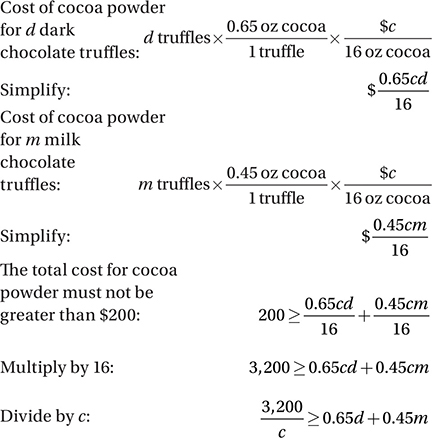
27. C
Advanced Mathematics (exponentials) HARD
Notice that this question asks us to find the value of 2n + 3, so we should try to solve the given equation for 2n + 3.
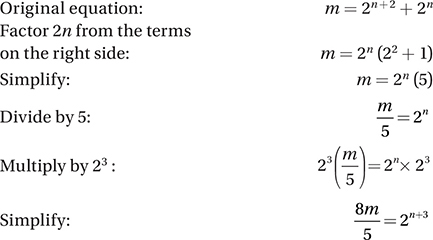
28. D
Special Topics (trigonometry) HARD
Although this question can be solved by graphing, it is simpler and more efficient to imagine the unit circle, as we discussed in Chapter 10, Lesson 9.
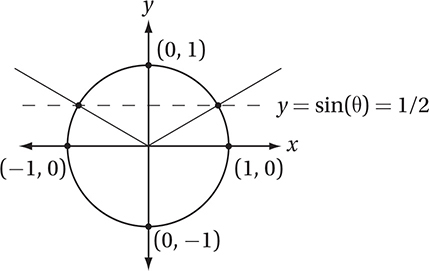
We are asked to consider those angles that have a sine of ½. As you recall from Chapter 10, Lesson 9, the angles whose sine is ½ correspond to those angles that intersect the unit circle at any point where y = ½, as shown in the diagram above. Notice that the line y = ½ intersects the unit circle in two points. We are asked to consider sin 3x, where x takes values from 0 to 2p. This means that 3x takes values from 0 to 6p. In other words, we are taking three complete trips around the unit circle (since each trip around is 2p radians). How many times will we visit those two points if we take three trips around the circle? Clearly (3)(2) = 6 times.
29. B
Advanced Mathematics (function transformations) HARD
The figure clearly shows that the function y = f(x) is similar in shape to the function y = g(x), but is shifted to the left by some positive distance. Recall from Chapter 9, Lesson 3, that when the graph of y = g(x) is shifted to the left by k units, the equation of the new function is y = g(x + k). The only equation that has this form is (B) f(x) = g(x + 2).
30. A
Data Analysis (data spread) HARD
One important rule in data gathering is, the more data we can gather on a population, the more reliable our statistics about that population will be. More specifically, the greater fraction of the population we can sample, the smaller our margin of error from the true value of the population statistic. Another important rule in data gathering is the more similar our sample is to the population of interest, the smaller our statistical error will be. Since the sample size is highest and the group is most like the population (of undergraduate computer science majors) in choice (A), that group should produce the smallest margin of error in the data.
31. 168
Algebra (percents) EASY
The sum of 40 and 80 is 120, and 40% of 120 is (0.40)(120) = 48, so the number that is 40% greater than 120 is 120 + 48 = 168. Also remember that increasing a number by 40% is equivalent to multiplying it by 1.4.
32. 3/2 or 1.5
Advance Mathematics (quadratics) MEDIUM
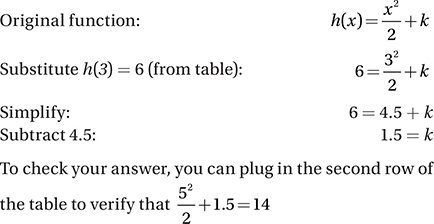
33. 52
Algebra (linear equations) MEDIUM
In Chapter 7, Lesson 5 we discussed the fact that the slope of a linear equation in “standard form,” ax + by = c is equal to -a/b. Therefore, the linear equation hx + 4y = -3 has a slope of -h/4. If this slope equals -3, then

34. 25
Algebra (word problems) EASY
Let’s let x be the larger number. 15 is the smaller number. The sum of the numbers is four times their difference:x + 15 = 4(x - 15)

35. 4/45 or .088 or .089
Special Topics (trigonometry) MEDIUM-HARD


This gives us the value of cos x, but we are asked to evaluate  , which of course is in terms of sin x.
, which of course is in terms of sin x.
This should remind you of the Pythagorean Identity we discussed in Chapter 10, Lesson 9: for all real numbers x, sin2 x + cos2 x = 1.
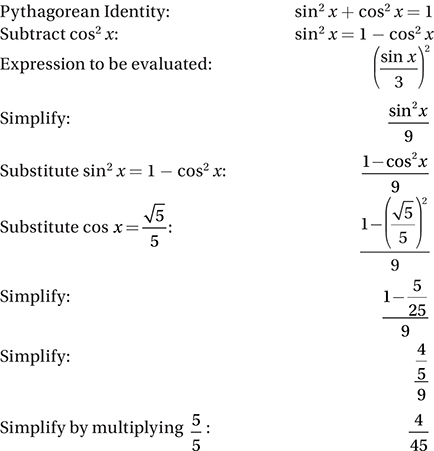
36. 75/4 or 18.7 or 18.8
Special Topics (arcs and triangles) MEDIUM-HARD
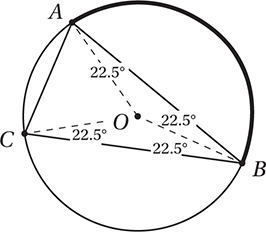
Let’s start by drawing the three radii OA, OB, and OC. Since these radii are all congruent, and because AB = BC, the triangles AOB and COB are congruent (by the SSS Theorem). This implies that OB bisects angle ABC, so the base angles of both isosceles triangles must have measure 45°/2 = 22.5°. Therefore, angle AOB, which is the central angle for arc AB, must have measure 180° - 22.5° - 22.5° = 135°. Now we can use the fact that the circumference of the circle is 50 to find the length or arc AB.


37. 47
Problem Solving (extended thinking) HARD
Let n equal the number of months that Isabelle has been on Plan A. If she has been on Plan A for over a year, then n > 12. This means that she has been on Plan A for n - 12 months beyond the first year. Since Plan A costs $500 for the first year and $80 per month thereafter, the total cost for her n months of service is $500 + $80(n - 12). If she had been on Plan B, the cost would have been $68 per month, or a total of $68n. If Plan B would have saved her

38. 32
Problem Solving (extended thinking) HARD
Since Plan C costs $92 per month and Plan B costs $68 per month, Plan C costs $92 - $68 = $24 more dollars per month than plan B. Since shifting plans would save her only 45 minutes of work, or 3/4 hour, each month, she would have to value one hour of free time over one hour of work time at $24/(¾ hour) = $32.
Section 5: Essay
Sample Response
James Schlesinger’s essay, “Cold Facts on Global Warming,” is a counterargument to the “political alarmism” (to use Schlesinger’s words) over global warming. His tone is critical but sober, and he makes frequent use of carefully selected scientific and historical data, juxtaposed with hints at the dangers of political posturing, to make the case for caution in addressing the issue of climate change. He appeals frequently to the ethics of economic prudence and global stewardship, as well as the value of scientific judiciousness. Unfortunately, because Schlesinger’s essay was written over a decade ago, it lacks the evidence from the current golden age of climate science. More substantially, however, Schlesinger undermines his own purpose by making political criticisms while calling for nonpartisan objectivity, by mongering fearsome scenarios while arguing against “scare tactics,” and by ignoring the scientific evidence against his claims while advocating an “emphasis on science.”
Schlesinger begins his discussion with a call for “facts and logic” over “rhetoric.” This is classic polemical posturing: we all believe that our positions are “factual and logical” and that our opponents’ are merely “rhetoric.” In Schlesinger’s view, the “rhetoric” includes the claims that “emissions of carbon dioxide are the primary cause of any change in global temperature and inevitably will lead to serious environmental harm in the decades ahead.” By inserting the modifiers “any” and “inevitably,” he creates a straw man. Most who argue about the seriousness of climate change generally avoid such absolute assertions and instead present evidence from satellites, ice cores, atmospheric analysis, and comprehensive long-term climatic studies to build a case for action. Schlesinger does not address this evidence.
In his argument, Schlesinger appears to value small government and the protection of American industry over the stewardship of the planet. His concern about the Kyoto Protocol of 1997 is not that it eschews the “facts and logic” of climate science, but rather that it “could cost $300 billion annually.” He presents no scientific critique of the Kyoto Protocol of 1997 beyond the assertion that Democrat Al Gore was “willing to embrace” a “treaty that would harm the economy,” and the vague claim that “the treaty’s flaws have become more evident.” His method of argumentation here appears to contradict his call for “facts and logic” over “rhetoric.”
In contrast to the irresponsibility of Al Gore and the Clinton administration, Schlesinger offers the soberly scientific Bush administration, which “focused on filling in gaps in our state of knowledge, promoting the development of new technology, encouraging volunteer programs, and working with other nations on controlling the growth of greenhouse gas emissions.” Schlesinger does not offer a specific benefit our planet has gained from these efforts, which even Schlesinger himself admits involved “spending more than $4 billion annually.” Someone pleading for fiscal responsibility might try to account for such a huge expenditure.
Schlesinger believes that our inaction on climate change is a virtue: that scientific prudence requires “filling the gaps in our state of knowledge” above everything else, including industrial restraint. He states that “what we know for sure is quite limited,” yet is confident enough in his limited knowledge to assert that “the theory that increasing concentrations of greenhouse gases like carbon dioxide will lead to further warming is at least an oversimplification,” directly contradicting the simple middle school experiment showing that a soda bottle filled with carbon dioxide warms far more quickly than one filled only with air.
Schlesinger then selects data trends that seem to support his call for caution, rather than action: he asserts that “satellite measurements over 35 years show no significant warming in the lower atmosphere” and that there was “atmospheric cooling from 1940 to around 1975.” Schlesinger does not explain why climate scientists, who are certainly aware of these data, nevertheless believe in anthropogenic global warming.
Not to be accused of cherry-picking data, Schlesinger next offers “a longer view of climate history.” He asserts that temperatures “were 1 to 2 degrees warmer than they are today” during the Climatic Optimum of the early Middle Ages, and this warming did not have “anything to do with man-made greenhouse gases.” Evidently, we should think that because it was warmer a very long time ago, burning coal today must not be changing the climate.
In the last two paragraphs, Schlesinger essentially retracts his concern about “filling the gaps in our state of knowledge” after all, because he believes it is impossible to fill the most important gaps: “It is not possible to know now how much of the warming over the last 100 years or so was caused by human activities and how much was because of natural forces.” So if it is impossible to know, we might ask, why should we expend “more than $4 billion annually” to study it? He does not say. We get Schlesinger’s most sonorous call to action in the last paragraph, where he suggests “engagement of the business community on voluntary programs.” That is, get big government off the backs of corporations and let them do as they please.
Scoring
Reading—4 out of 4
This response demonstrates a very strong and thorough comprehension of Schlesinger’s essay through skillful use of summary, paraphrase, and direct quotations. The author summarizes Schlesinger’s central tone, thesis, and modes of persuasion (His tone is critical but sober, and he makes frequent use of carefully selected scientific and historical data, juxtaposed with hints at the dangers of political posturing, to make the case for caution in addressing the issue of climate change.) and shows a clear understanding of how Schlesinger’s supporting ideas string together and serve his overall thesis (Schlesinger begins his discussion with a call … He appears to value small government … Schlesinger offers the soberly scientific Bush administration … Schlesinger believes that our inaction on global warming is a virtue … Schlesinger next offers … In the last two paragraph, Schlesinger essentially retracts his concern). Importantly, this response also offers abundant supporting quotations to illustrate each paraphrase. Taken together, these elements demonstrate outstanding comprehension of Schlesinger’s essay.
Analysis—4 out of 4
Although this response occasionally veers toward advocacy, it never turns away from careful analysis. Indeed, its thoughtful and thorough critique of Schlesinger’s essay demonstrates a sophisticated understanding of the analytical task. The author has identified Schlesinger’s primary modes of argument (He appeals frequently to the ethics of economic prudence and global stewardship, as well as the value of scientific judiciousness) and even uses those standards to analyze Schlesinger’s essay itself, and indicates points at which Schlesinger’s argument seems self-defeating (Schlesinger undermines his own purpose by making political criticisms while calling for nonpartisan objectivity, by mongering fearsome scenarios while arguing against “scare tactics,” and by ignoring the scientific evidence against his claims while advocating an “emphasis on science”). Overall, this analysis of Schlesinger’s essays demonstrates a thorough understanding not only of the rhetorical task that Schlesinger has set for himself, but also of the degree to which it upholds its own standards.
Writing—4 out of 4
This response demonstrates an articulate and effective use of language and sentence structure to establish and develop a clear and insightful central claim that Schlesinger’s essay is a counterargument to the “political alarmism” … over global warming … but that it undermines [its] own purpose. The response maintains a consistent focus on this central claim, and supports it with a well-developed and cohesive analysis of Schlesinger’s essay. The author demonstrates effective choice of words and phrasing (undermines his own purpose … mongering fearsome scenarios … Schlesinger believes that our inaction on climate change is a virtue), strong grasp of relevant analytical and rhetorical terms, like economic prudence, nonpartisan objectivity, and polemical posturing. The response is well-developed, progressing from general claim to specific analysis to considered evaluation. Largely free from grammatical error, this response demonstrates strong command of language and proficiency in writing.